200+ Euphorbia Spurge Types With Names and Pictures
Get ready for an exciting adventure into the enchanting realm of Euphorbia plants! These incredible succulents, which originally come from South Africa but can now be found all around the globe, are sure to capture your imagination. We’ll take a closer look at over 200 fascinating types of Euphorbia and discover tips to help you care for them. Let’s dive in and watch your garden transform into a magical oasis with these special plants!
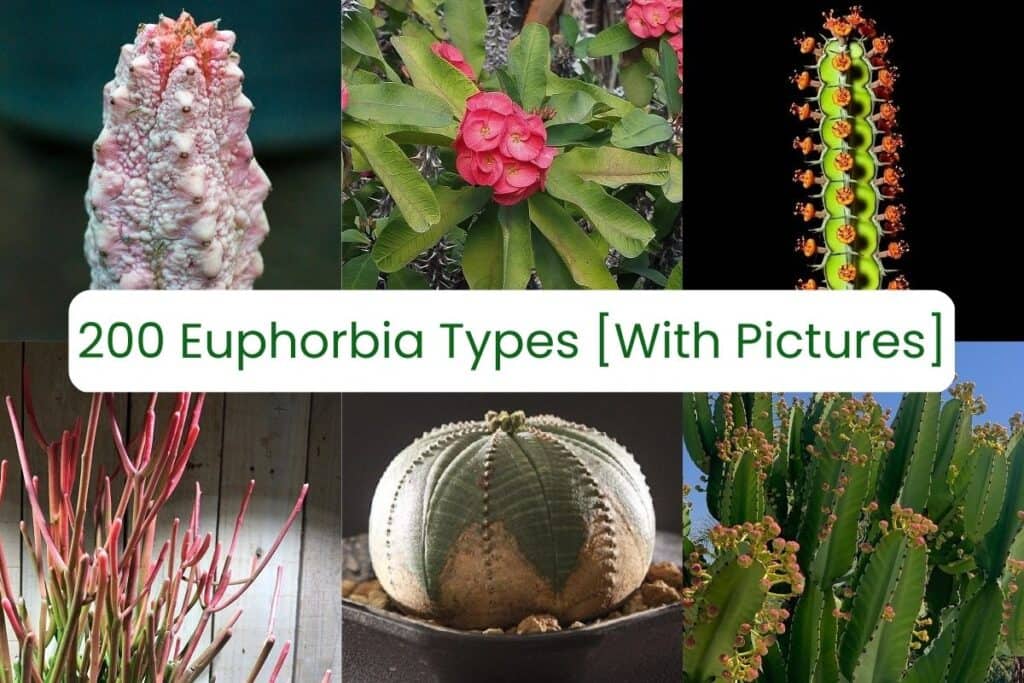
Related Post:
1,000 Types of Succulents With Pictures
Contents
Types of Euphorbia With Names and Pictures
Euphorbia abdelkuri
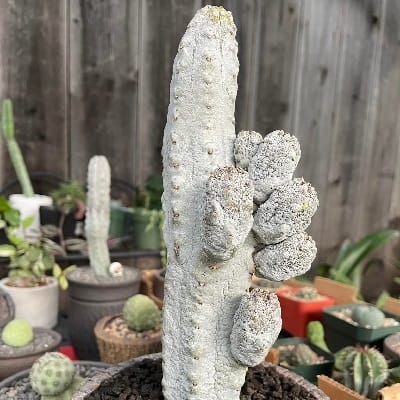
Euphorbia abdelkuri is a very peculiar candelabra-like succulent plant lacking both leaves and spines, which looks like a grey candle with whitish-grey melted wax on it.
It forms densely branched candelabra-like clumps usually not more than 1 m high by 1.5 in diameter on one clump (but occasionally in habitat some plants can reach 3 m of height and an equivalent diameter). It is one of the most coveted Euphorbia species.
Euphorbia abdelkuri Damask
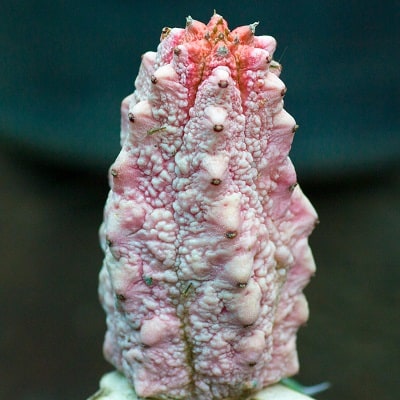
This charming cultivar differs from the standard Euphorbia abdelkuri in its pinkish-reddish body-color, varying in intensity with light levels.
Euphorbia abyssinica
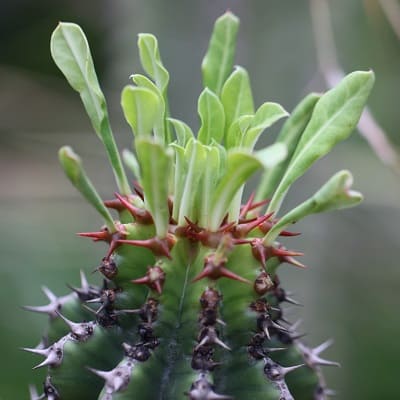
Euphorbia abyssinica is a nice large, cactus-like, candlestick, tree Euphorbia with short thorns. It forms a dense crown of ascending branches usually up to 4,5 m tall (but reported to reach 9 or more meters of height).
E. abyssinica is a highly variable species with several forms and making precise descriptions may be difficult.
Euphorbia actinoclada
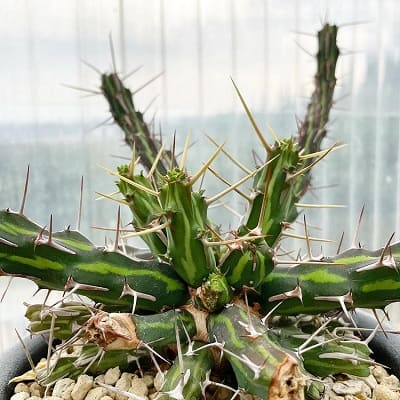
Euphorbia actinoclada is a dwarf spiny, perennial, succulent shrublet up to 50 cm in diameter and 15 cm tall, but usually smaller, with a fleshy root merging into a short thick rootstock (often called a caudex).
The upright branches are up to 15 cm long and 1 cm in diameter and spread in the upper part. Their surface is dark green with brighter longitudinal stripes. The flowers (cyathia) are reddish.
Euphorbia aeruginosa
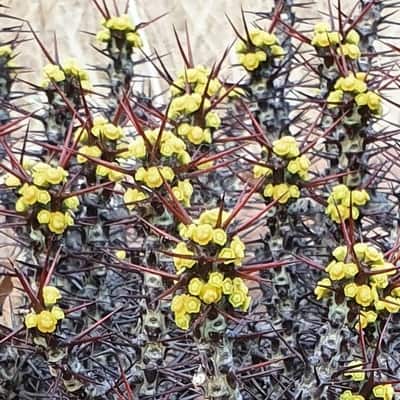
Euphorbia aeruginosa is a very decorative spiny, succulent, forming dwarf, shrubs 15-30 cm in height (up to 40 cm recorded north of Punda Milia) and a subterranean caudex. Branches bluish-grey or brownish-green with many brownish spines. Branching occurs at or below ground level and above too.
Its name, which means ‘verdigris’, refers to the coppery-green branches which have contrasting reddish-brown spines.
Euphorbia aggregata
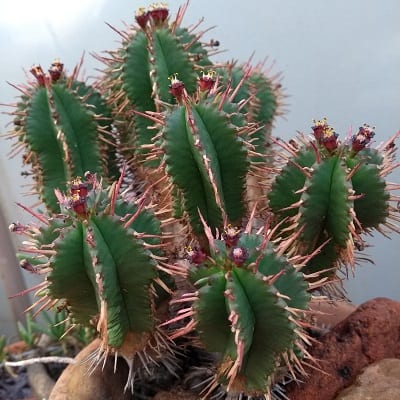
Euphorbia aggregata is a dwarf dioecious succulent shrub, very spiny and free-branching that forms a low tufted cushion-like mass composed of hundreds of heads that grows up to 1 m in diameter, but very old large plants with up to 40.000 (or even more) heads have been reported.
E. aggregata is closely related to Euphorbia ferox and Euphorbia pulvinata, which can be recognized by their striking growing shape. Therefore its more likely that intermediate forms between the mentioned species will occur in the habitat. The fierce peduncles that characterize Euphorbia ferox are few in number on this species.
Euphorbia albipollinifera
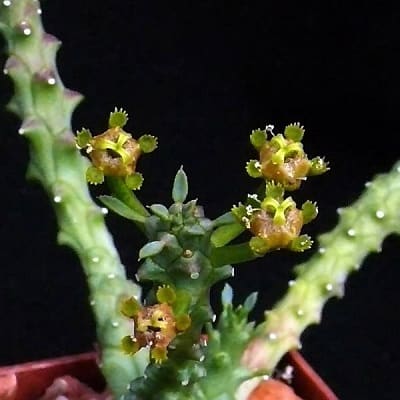
Euphorbia albipollinifera, named after its unusual pure white pollen, is one of the lesser-known medusoid type euphorbias, with a subglobose body, tuberculate, central apical area, and relatively few spreading branches up to 75 mm long.
Euphorbia alluaudii
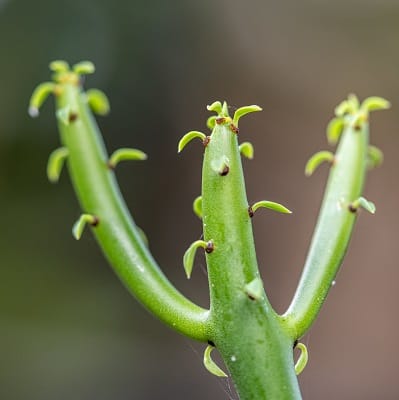
Euphorbia alluaudii (Cat Tails Euphorbia) is a dioecious (exceptionally monoecious) succulent shrub or small tree made up of clusters of cylindrical, jointed, spineless branches. Most of its branches rise erectly from the base and then arch outwards to form a mass as wide as tall.
It can ultimately reach 4(-6) meters though in containers it more commonly grows to a modest 1.2-1.8 meters tall. At the tips of the stems, small yellow flowers will appear in the spring and summer and the developing fruit is red and somewhat heartshaped.
Euphorbia ambovombensis
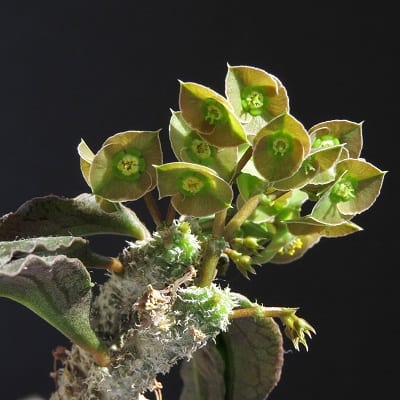
Euphorbia ambovombensis is an amazing dwarf geophyte succulent with a round or oval fat base (caudex) topped with several erect branches and spirally arranged leaves creating an almost animated appearance. It eventually becomes a small shrubby bush up to 35 centimeters over time.
Euphorbia ammak
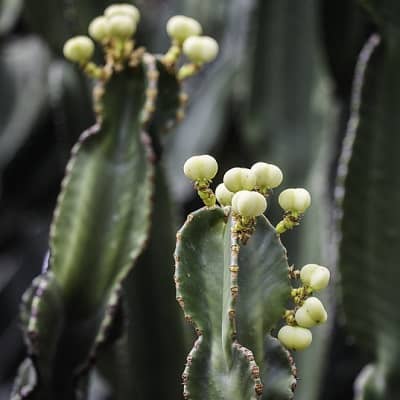
Euphorbia ammak is a striking Euphorbia of massive stature that resembles Euphorbia candelabra. It branches but not profusely. It is a typical representative of large, tree-like Euphorbias that can grow up to 10 m tall with a short trunk, it is superficially similar to some new world Cacti. The upright broadly obconical crown of this plant makes it looks like a branched candelabra.
Euphorbia ankarensis
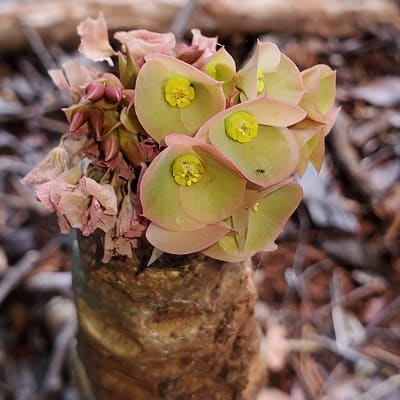
Euphorbia ankarensis, as is implied by the specific name, is a rare and localised species confined to the ‘Falaise d’Ankarana’ in NW Madagascar. It has short fleshy sticks with attractive pale green cones of cyathophylls at the top, followed by deciduous leaves which are shed at the beginning of the dry season.
Euphorbia antiquorum
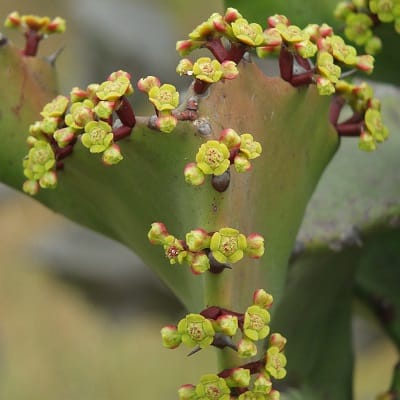
Euphorbia antiquorum is one of the largest armed tree Euphorbias, cactus-like in appearance with a rugged elegance growing up to a height of 5 – 7 m, branched and branched to form a loosely rounded crown, it has been known to attain gigantic proportions if left undisturbed, but usually shrub-like.
A small population of giants was discovered by a survey team from the Botanical Survey of India in a secluded part of Kalakkad Reserve forest (alt. 800 m), reaching a height of 20 m and a trunk of 1 m diameter.
Euphorbia aphylla
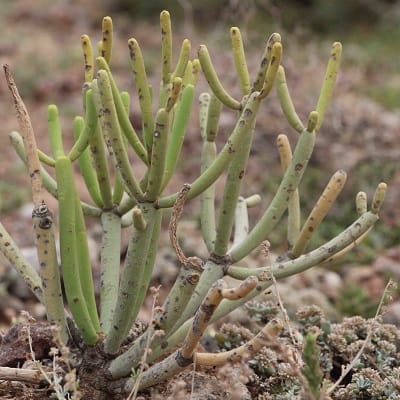
Euphorbia aphylla is a small, evergreen, densely branched and succulent shrub 30-80(-250) cm tall. The pencil-like shoots (apparently missing leaves) arise from a short trunk and branch further into whorls. The species name ‘aphylla’ comes from the Greek for ‘without leaves’.
Euphorbia arbuscula

Euphorbia arbuscula is an impressive leafless shrub or broad-crowned candelabrum tree 3-7 m high that produces a white resinous exudate when cut. It is a succulent plant without real leaves, where photosynthesis is guaranteed by the green parts along with the tips of the branches.
The mature specimens are gorgeous trees that provide shade from the scorching sun, as the dense crown has no leaves to shed. Irregularities in the shape of the individual, especially aged, trees are due to traumatic events which change the vitality of one or more branches. The fruits are brown.
Euphorbia atrispina
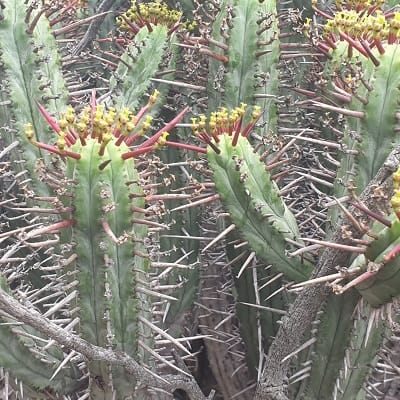
Euphorbia atrispina is a dioecious ‘cushion’ euphorbia, branching densely from the base. Apart from the fact that the species is a dwarf (7-20 cm high), no important features distinguish it from its close allies, Euphorbia heptagona and Euphorbia enopla which have a larger, bushy habit.
These three spiny shrubs are difficult, if not impossible, to distinguish. Euphorbia atrispina is really beautiful, easy to grow and looks best in cultivation when young and goes on to produce large mounds with time.
Euphorbia atropurpurea
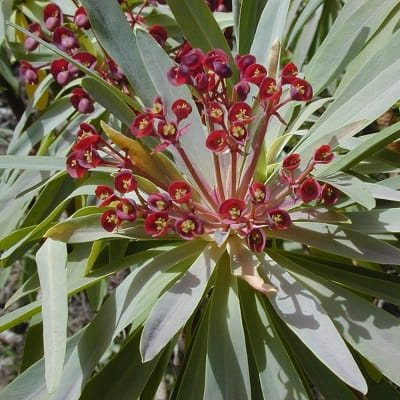
Euphorbia atropurpurea comes from the Canary Isles and is hence one of the hardier species from this genus. It is a shrub that can reach 1.5-2 meters in height or more, with dichotomous fleshy branches with long pointed leaves and the inflorescence is in the form of a mass of bronze-purple or rarely yellowish (f. Lutea) bracts greater than 1 cm in size.
Euphorbia atroviridis
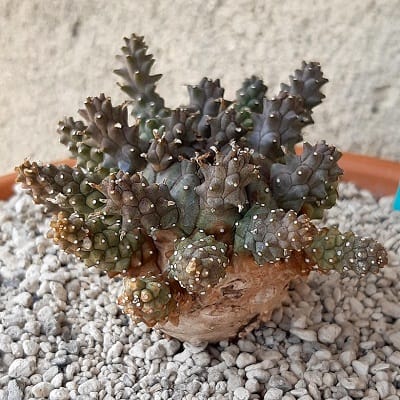
Euphorbia atroviridis n.n. J & R 359 Seekoegat is an undescribed name (never published). It refers to an old cultivated plant widely available in culture. Originally distributed as Euphorbia species nova De Lange 163, and later provided with the provisional name atroviridis. E. ‘atroviridis’ is a medusa-head Euphorbia with a considerable tap root.
E. atroviridis slowly branches with age. Euphorbia atroviridis is a close relative of the gorgonis-like species, a striking feature of Euphorbia atroviridis is that the involucre glands partly bend backward as compared to other medusae-heads of the central Great Karoo.
Larger plants with similar flowers have been found many kilometres to the east in the vicinity of Pearston.
Euphorbia atrox
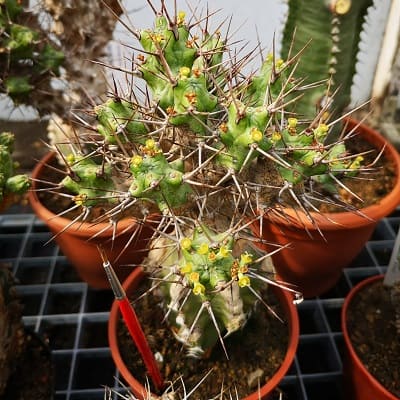
Euphorbia atrox is a spiny perennial succulent that forms small conical shrubs up to 30 cm tall and 40 cm in diameter.
Euphorbia avasmontana
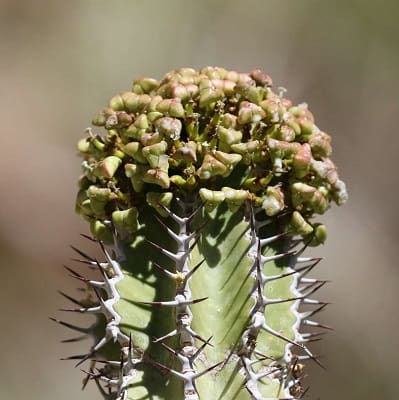
Euphorbia avasmontana is a many-stemmed, spiny, columnar cactus-like succulents branching at the base, 2-2.5 m tall that can sucker to nearly as wide.
Euphorbia baionensis
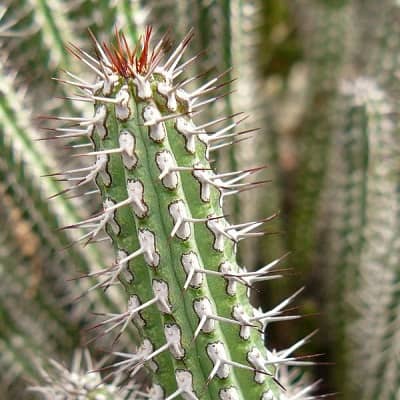
Euphorbia baionensis forms small clustered shrubs up to 30 cm tall.
Euphorbia balsamifera
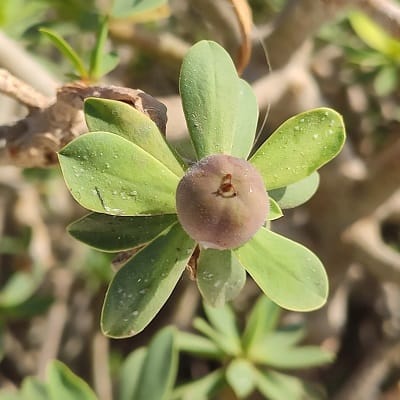
Euphorbia balsamifera forms dichotomously branched, rounded shrubs of variable height from very short bushes with creeping stems exposed to the wind hardly rising above the ground to small trees 1 to 3(-5) meters tall. It forms a thick succulent trunk, a real natural bonsai.
Euphorbia balsamifera differs from other species of the genus by having a single-flowered terminal inflorescence. Also like other Euphorbia, it is unisexual, with male and female flowers on separate plants. It is pretty variable where leaf characters and stem development are concerned.
In summer it loses its leaves and reveals a bare tree trunk looking like death. In reality, it is not dead but it is a summer deciduous. In order to prevent the loss of water through their leaves in times of drought and high temperatures, the plants choose to lose them, even if it means stopping the photosynthesis process and entering into a rest phase.
Euphorbia beharensis var. guillemetii
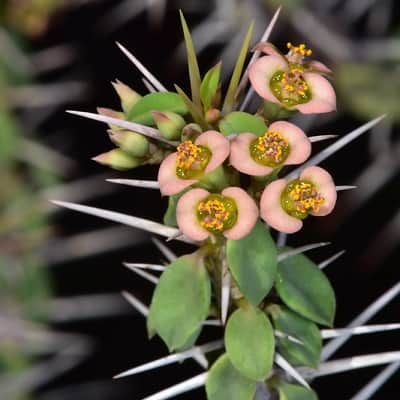
Euphorbia beharensis var. guillemetii (a.k.a. Euphorbia guillemetii) is a sprawling shrublet with dark brown-green leaves that are sparsely arranged along the spiny branches. The cyathia (flowers) are small and dirty yellow.
It is easily distinguished from Euphorbia beharensis by its shorter spines 3-8 mm long and longer leaves up to 12 mm long and 4 mm broad.
Euphorbia bisellenbeckii
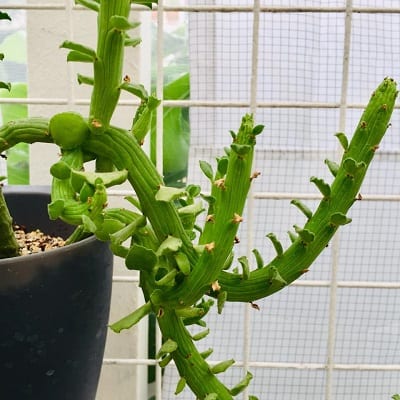
Euphorbia bisellenbeckii is a low-growing shrubby succulent perennial herb with fleshy, serpent-like stems that emerge from a central base.
Euphorbia bongolavensis
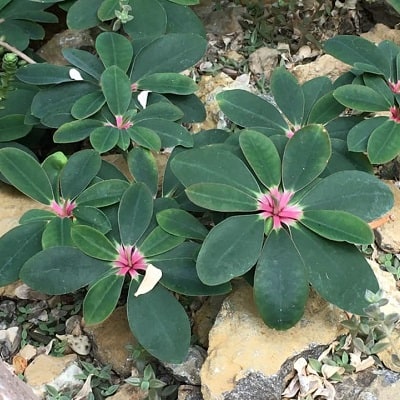
Euphorbia bongolavensis is a shrublet up to 1 metre tall, closely related to Euphorbia hedyotoides and Euphorbia umbraculiformis. All these peculiar plants are differentiated into an upright branchless stem and a much-branched, umbrella-like crown.
The main stem stops elongating by the formation of brachyblasts (short, densely crowded shoots bearing clusters of leaves) that produce an umbrella-like open crown.
Though not really a succulent but a very slow-growing xerophyte, Euphorbia bongolavensis is a real must grown by succulent enthusiasts. It has uniquely colored leaves with bases of red and the rest of the lanceolate-shaped leaves a green to bluish green (depending on how much sun or shade).
The flowers are reduced in size and aggregated into a cluster of yellow flowers called cyathia.
Euphorbia brachyphylla
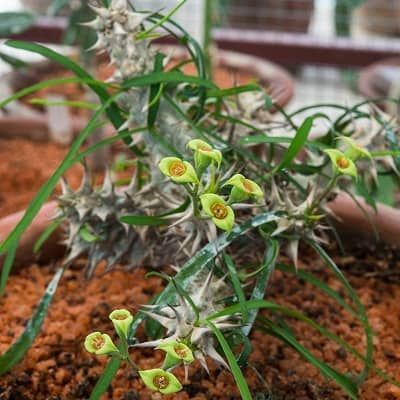
Euphorbia brachyphylla is a spiny succulent shrub, 1-1.2 m tall, scarcely branched, with hairy spines at the ends of the branches accompanied by smaller spines, with green-yellow to salmon-pink flowers.
Euphorbia bracteata
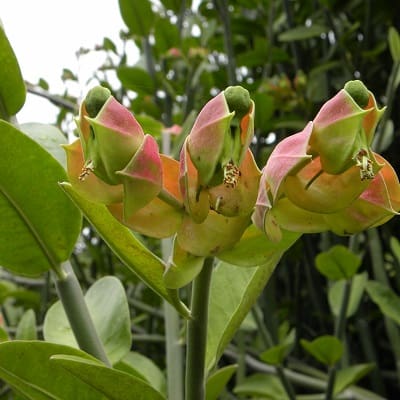
Euphorbia bracteata) is a small evergreen or deciduous shrubs growing to around 1,8 m tall (to 3 m tall in habitat), 0,9-1,2 m wide that branches profusely from the base; It produces abundant flowers (cyathia) with somewhat shoe-shaped reddish-colored bracts that give this species the common name Slipper Plant.
Euphorbia brunellii
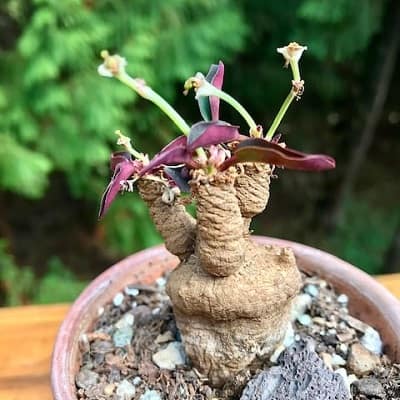
Euphorbia brunellii is a small geophyte, perennial, succulent plant that flowers early in spring before putting out the leaves. The flowers are either white or pinkish.
Euphorbia bulbispina
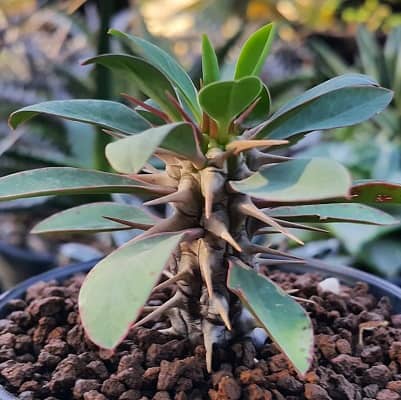
Euphorbia bulbispina is a dwarf shrublets to 30 (or more) cm, much-branched and spreading to 1 meter and more in diameter. E. bulbispina is part of the large and variable Euphorbia milii group, but it differs from all other varieties by its dwarf growth form and its peculiar branching.
While many E. milii forms show a shrubby or tree-like habit, which is to say that they are branched from the base and no main stem can be discerned, E. bulbispina possesses a prominent main stem just in the juvenile stages.
Therefore E. bulbispina has the same growth form as the large arborescent coralliform euphorbias of southern Madagascar, only smaller.
Euphorbia bupleurifolia
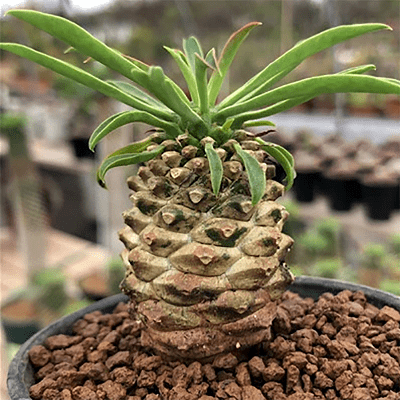
Euphorbia bupleurifolia is a low-growing, spineless plant with a short caudiciform trunk that looks like a small pine cone topped with a crown of green leaves. The whole plant abounds with milky juice.
Euphorbia buruana
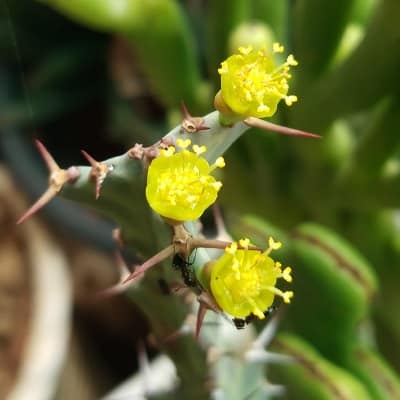
Euphorbia buruana is a perennial succulent spiny shrublets with a large tuberous pseudo caudex, i.e., “fat root” that produces a tuft of three-winged succulent branches variegated with attractive decurrent streaks of yellowish-green in a pattern reminiscent of marble giving the stems a stretched appearance.
It is monoecious having both male (center portion) and female (sides) parts on the same cyathia.
Euphorbia caducifolia
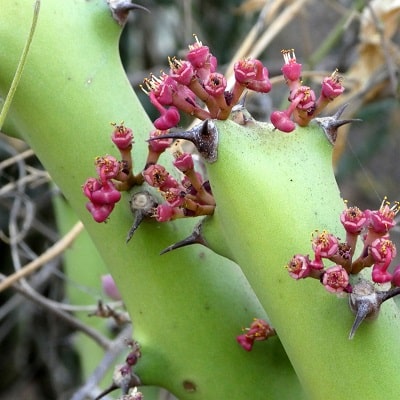
Euphorbia caducifolia (a.k.a. Leafless Milk Hedge) is a great-looking, sparsely spiny columnar branching Euphorbia. It is very similar to Euphorbia nivulia (Leafy Milk Hedge).
It differs chiefly in being a many-stemmed, cactus-like, shrub forming dense, dendrite thickets up to 2(-3) m tall and 4(-10) m across, with numerous branches arising from the very base and at the top. It differentiates also in having smaller readily-falling leaf-blades.
The plant is very variable in relation to the size and density of spines, the shape and size of leaves and the thickness, and sometimes the color of the stem.
Euphorbia caerulescens
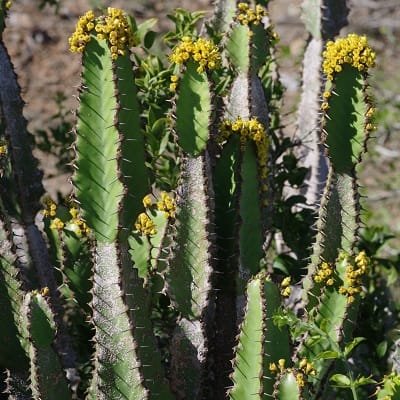
Euphorbia caerulescens is a small, columnar, thorny, leafless, succulent shrub with a pretty irregular shape. 0,5- 1.5 m tall that can sucker to nearly as wide. It forms a tufted crown of thick, cactus-like, short branches divided into many joints spreading underground.
Euphorbia canariensis
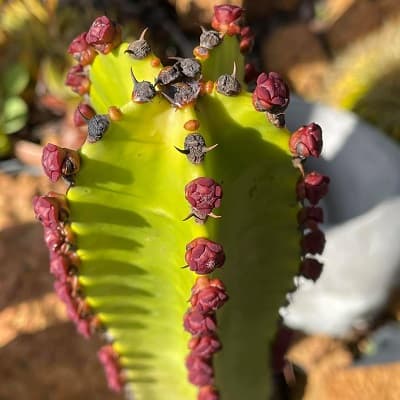
Euphorbia canariensis is a small succulent shrub, 1 to 3(-4) m high. It clumps profusely from the base, one trunk may produce more than150 branches as thick as a man’s arm.
Euphorbia caput-medusae
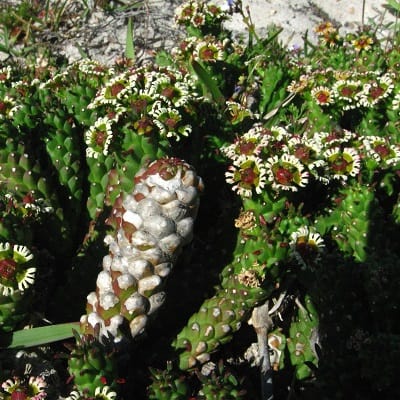
Euphorbia caput-medusae is a sprawling, succulent shrub that resembles the head of Medusa, with a rosette of narrow, serpent-like stems arising from a short, central caudex. The whole plant sometimes exceeds 1 meter in diameter, but more frequently is about 40-70 cm wide.
Euphorbia celastroides
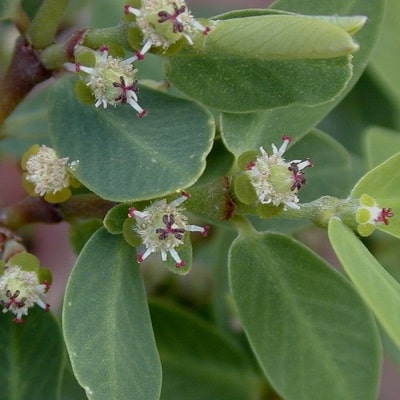
Euphorbia celastroides is a species of spurge that grows as a medium-sized evergreen shrub or small tree reaching at most 1-2 m in height and diameter. This species develops into a round-shape shrub, both glabrous and pubescent forms are known.
While the flowers are not showy, the bright pinkish to red fruits can be uniquely appealing en masse.
Euphorbia cereiformis
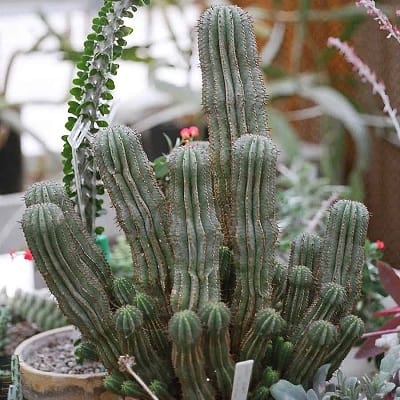
Euphorbia cereiformis is commonly called the Milk Barrel Cactus. These succulents grow at a rapid speed and produce several offsets and clumps that grow towards the outside.
Euphorbia characias ‘Silver Swan’
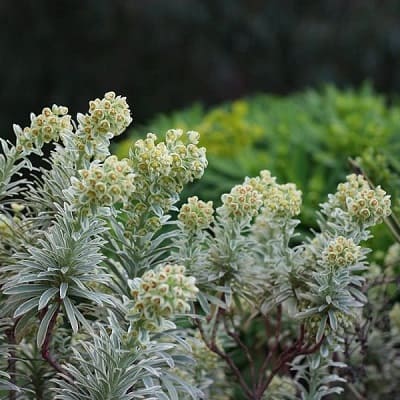
Euphorbia Silver Swan is a finicky plant and is quite rare. The green leaves are variegated with silver and white marking and grow in clusters of rosettes protruding outwards.
Euphorbia clandestina
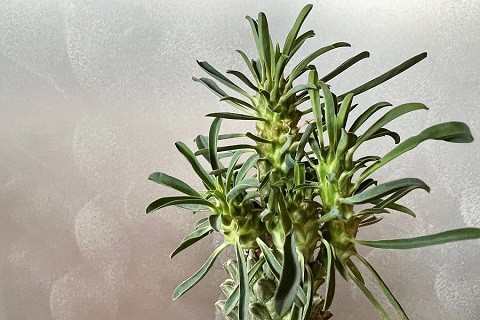
Euphorbia clandestina has its origins in South Africa and is an evergreen succulent plant. It is also commonly referred to as the Ostrich Neck and usually grows around rocky regions.
Euphorbia clava
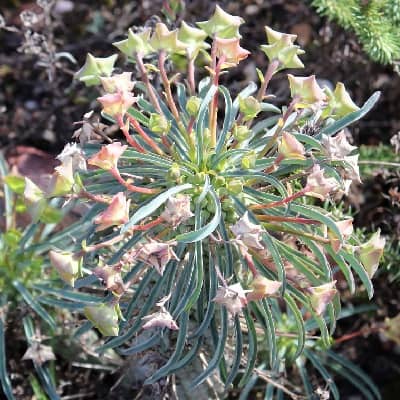
Euphorbia clava is a succulent shrublet 60 to 1.5 m tall producing a dense cluster. It is characteristically club-shaped when young.
Euphorbia clavarioides
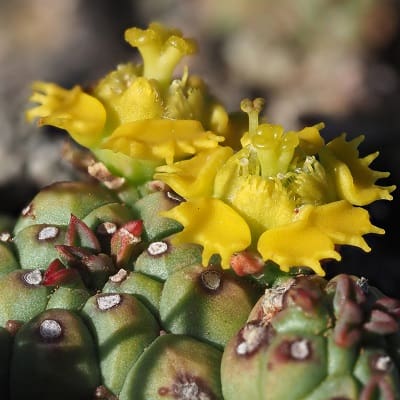
Euphorbia clavarioides is a low-growing succulent plant forming small cushion-shaped masses at ground level 5-7.5 cm high and 10-30 cm in diameter composed of the tips of unarmed, succulent, branches.
The main stem is a continuation of the root and is completely buried in the ground. The many branches which are cylindric or clavate are covered with tubercles. It has an inflorescence in the form of cyathium (apparently a single flower, actually several). The cyathia are produced at the tips of the branches.
Euphorbia columnaris
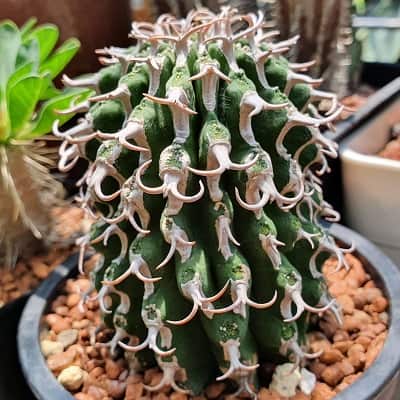
Euphorbia columnaris is a slow-growing columnar species with distinctive spines that resemble cactus. It is probably the rarest euphorbia of all. The spines are 2 cow-horn shaped, greyish to chalky-white that line the ribs.
Euphorbia confinalis
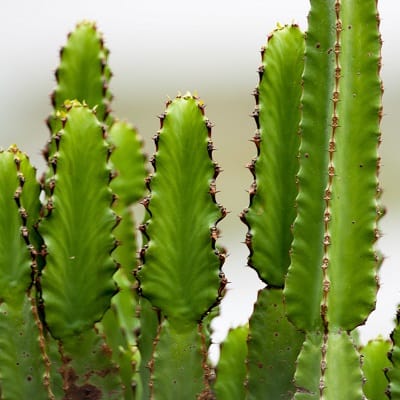
Euphorbia confinalis is an elegant, spiny, succulent tree. It is a slender, single-stemmed, leafless candelabra-shaped tree, often with secondary stems along the main trunk; with a round canopy of upward-growing branches, 3-10 m tall.
Euphorbia cooperi
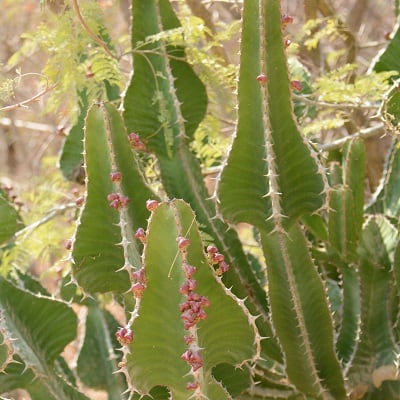
Euphorbia cooperi is a spiny, succulent tree 4-7 m tall, with conspicuous candelabra-like branches. The branches do not split again, unlike the common tree Euphorbia. Old dead branches hang underneath the compact crown for a while.
Over time all lower branches shed in a continual process leaving the top branches to accentuate the candelabra form.
Euphorbia crispa
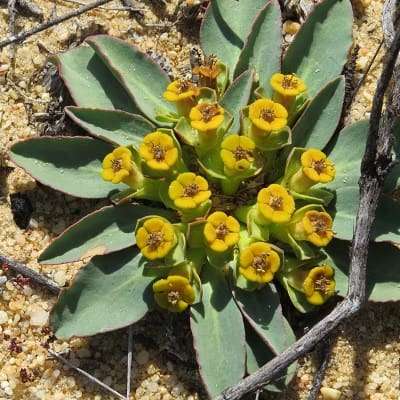
Euphorbia crispa is a stemless, dioecious (unisexual), tuberous-rooted geophyte herb, forming a short elongated, perpendicular body, wholly buried in the ground with the tip at ground-level producing leave and inflorescences. The leaves, produced for a short while each year, appear flat on the ground.
Euphorbia cylindrifolia
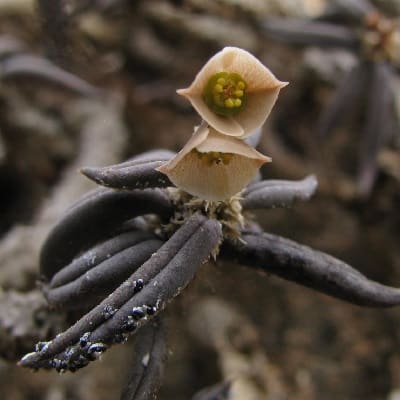
Euphorbia cylindrifolia is a dwarf, low-growing cushion-forming succulent with a rosette of narrow, serpent-like stems arising from a central caudex. The leaf blades are cylindrical with a longitudinal groove on the upper surface. It spreads by means of subterranean stolons rooting below ground.
Euphorbia debilispina
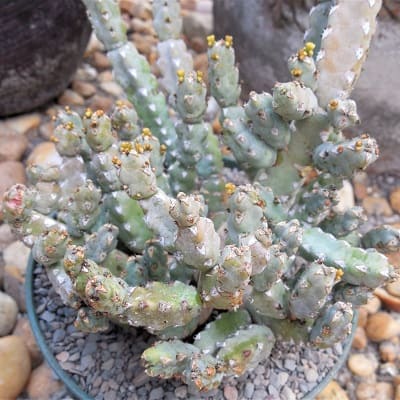
Euphorbia debilispina is a dwarf perennial succulent shrublet. It is densely branched and grows to about 10-20 cm in height and spread by means of subterranean stolons.
Euphorbia decaryi
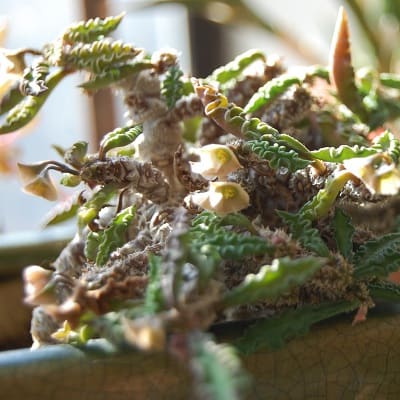
Euphorbia decaryi is a small, perennial, leafy succulent with a shrub-like development and beautiful wavy, zig-zag-edged leaves. It is a mat-forming species and spreads almost horizontally on the ground by means of rhizomes.
The Euphorbia decaryi growth form illustrates the typical horizontal habit of most Madagascan euphorbias. It is one of the most popular and widely grown Madagascan euphorbias.
Varieties of Euphorbia decaryi:
Euphorbia decaryi v spirosticha
Euphorbia decepta
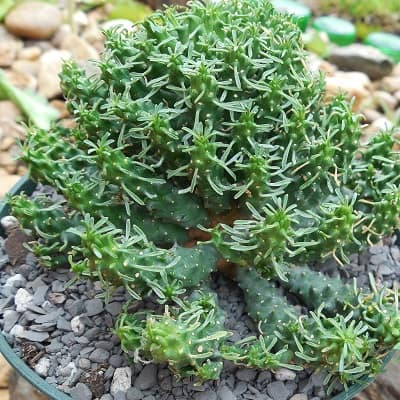
Euphorbia decepta is a dwarf, leafless and spineless succulent less than 80 mm tall, with a flattened, tuber-like stem, or caudex, partly buried in the ground, but the branches are beset with the dry, rigid remains of the peduncles, not spine-tipped, all scarcely above soil level.
The stem and branches are so much like the dry ground in color, that at a short distance they would not be easily detected.
Euphorbia decidua

Euphorbia decidua is a dwarf and very slow-growing spiny perennial succulent with a large turnip-like woody tuberous root. Flowers are pale green with a red center.
Euphorbia degeneri

Euphorbia degeneri, known in Hawaii as ‘akoko’, is a sprawling, prostrate shrub that commonly has a spread of 20-40 cm, but can also have a spread of 60 or more cm in width. This species normally is prostrate, but occasionally (especially in cultivation), it may grow up to a 60 cm tall shrub.
The form of the plant is considerably different in cultivation, due to the abundance of rapid growth that it makes. This plant in the summer assumes a purple-red coloring and keeps its leaves in winter.
Euphorbia dendroides

The Tree Spurge (Euphorbia dendroides) is a much-branched woody shrub with red bark, hemispherical, up to 2 m tall and wide, with basal shoot branching mostly dichotomously, and white milky juice (or small tree up to 3 m tall ).
The very original growth form of E. dendroides is named “round-topped tree”. The spherical form is the result of a peculiar forked branching growth, after the first development of flowers the growing apex is replaced by a shoot innovation with generally two lateral buds.
The leaves are formed in groups at the ends of the branches. Each adult plant produces hundreds to thousands of inflorescences (cyathia) grouped in clusters of one to 6 (rarely six) cyathia (flowers) subtended by yellowish petal-like bracts. It is the largest and the only arborescent European euphorbia.
Euphorbia discoidea
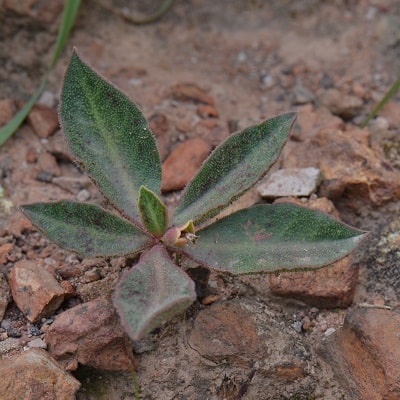
Euphorbia discoidea is a geophytic perennial herb, with a tuberous root, also called a caudex, with fleshy upright annual stems topped with a leaf crown. All above-ground parts are hairy. The flowers are yellowish-green or often flushed reddish.
Euphorbia dregeana
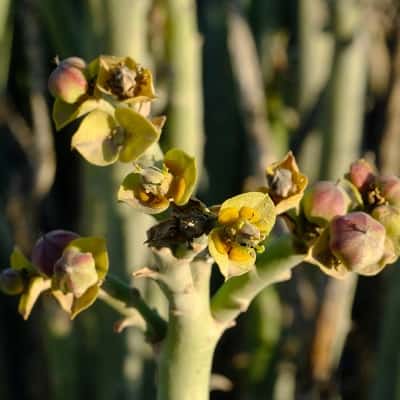
Euphorbia dregeana is a finger-like succulent branching much at the base and above into a multitude of erect cylindrical green stems, radiating out to form a rounded bush 90-200 cm high and as much or more in diameter. The smooth, whitish-green stems topped with umbels of flowers make it an attractive plant.
The flowers are yellow with two yellowish-green rounded petal-like lobes encircling the emerging six-sectioned seed capsule. It is the tallest and largest of the narrow-stemmed South African shrubby species with terete branches.
Euphorbia duseimata

Euphorbia duseimata is a small medusa-type shrublet up to 6 cm tall with tuberous stems merging into roots that grow deep. In cultivation, plants attain larger sizes and can grow up to 30 cm tall. It is closely related to Euphorbia fusca.
Euphorbia echinulata
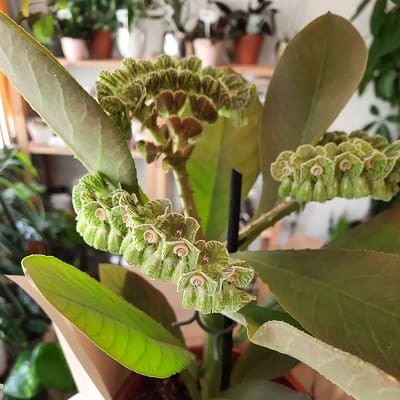
Euphorbia echinulata is a dwarf perennial herb that grows annual shoots from underground tubers. It has nice stem and leaves.
Euphorbia ecklonii
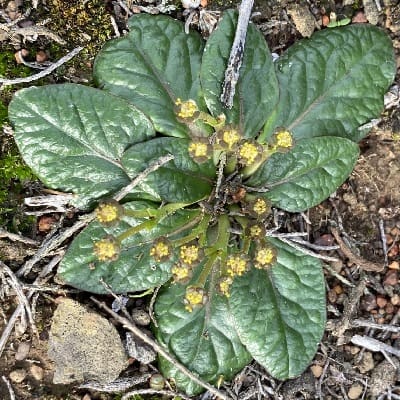
Euphorbia ecklonii is a dioecious (male and female plants separate) geophyte herb with broadly elliptical leaves, produced for a short while each year, appearing pressed to the ground. In this succulent plant, the stem seems to be almost absent, the water supply being lodged in the tuberous root.
Euphorbia enopla
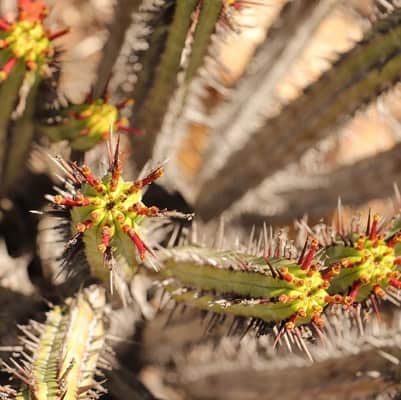
Euphorbia enopla is a heavily branching dioecious succulent spiny rounded bush that grows to about 30-100 cm, much-branched from the base, profusely covered with thick, prominent lovely long red spines.
Euphorbia enormis
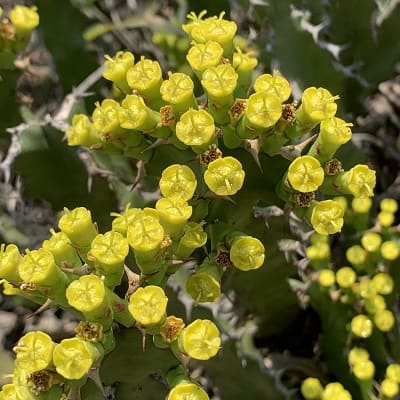
Euphorbia enormis is a dwarf succulent spiny shrublet with a large obconic or somewhat carrot-like pseudo caudex, i.e., “fat root” branching at ground level to form a tuft of twisted 4-winged succulent green. It is monoecious having both male (center portion) and female (sides) parts on the same cyathia.
Euphorbia enterophora
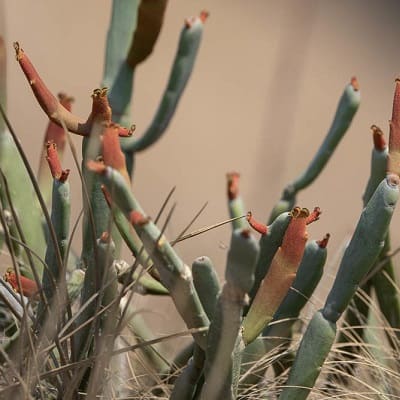
Euphorbia enterophora is a ‘cactoid’ Euphorbia forming a large much-branched shrub or even tree with a broad crown and woody base occasionally up to 20 m tall. It grows upward at first but as it adds branches, the plant sprawls laterally forming a large irregular mass.
It is almost leafless and one of the few species with fleshy, flat, ribbon-like shoots reminiscent of the Christmas Cactus.
Euphorbia erigavensis
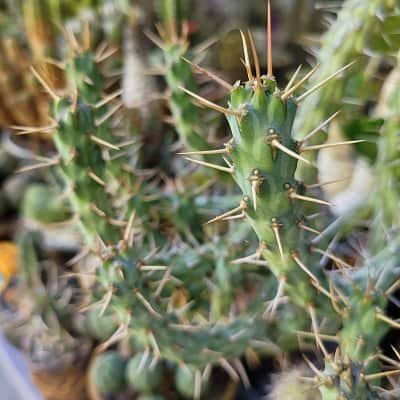
Euphorbia erigavensis is a spiny perennial succulent that forms small shrubs up to 30 cm tall from a thick very low trunk.
Euphorbia erythraeae
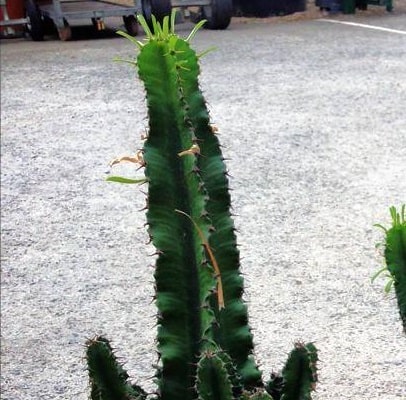
Euphorbia erythraeae is one of the innumerable local forms of the very variable Euphorbia abyssinica. It is a nice large, cactus-like, candlestick, tree Euphorbia with short thorns. It forms a dense crown of ascending branches usually up to 4,5 m tall (but reported to reach 9 or more meters of height).
Euphorbia erythraeae f. variegata
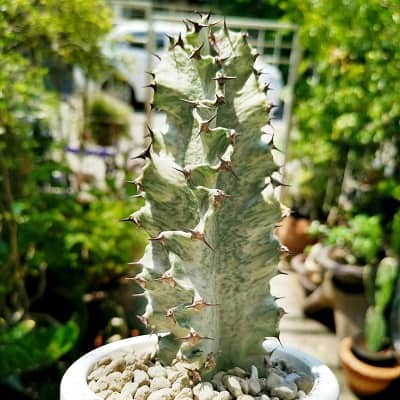
The Euphorbia erythraeae f. variegata has cream, yellow and pale-green variegated stems.
Euphorbia fasciculata
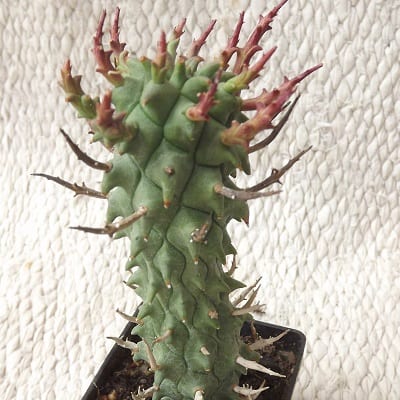
Euphorbia fasciculata sensu N. E. Br. p.p. non Thunb. (= E. schoenlandii) is a small pickle-shaped succulent shrublet with prominent spiny tubercles, sometimes resembling a green pineapple, usually single-stemmed but may branch with age.
The name “fasciculata” is often reserved in cultivation to distinguish E. schoenlandii specimens with thinner and very long upright spines.
Euphorbia ferox
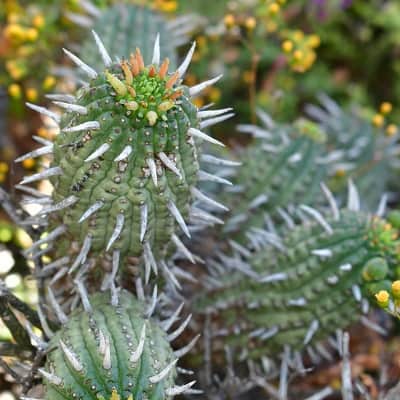
Euphorbia ferox is a small spiny succulent shrublet branching at the base. It will form rounded clusters up to 60 cm in diameter. The spines are indeed solitary sterile peduncles. They are very numerous, about 6 mm apart, stout, spiny rigid, 1-6 cm straight, reddish turning purple and finally grey.
Euphorbia ferox has a large area of distribution and is a very variable species.
Euphorbia fianarantsoae

Euphorbia fianarantsoae is a spiny, succulent shrub up to 50 cm tall, branching densely from the base. The leaves are lanceolate, clustered at the tip of the branches.
The inflorescence is a cyathium with yellow or reddish yellow bracts that form a cup-shaped petal-like structure around a female flower surrounded by five male flowers. The inflorescences appear at the top of the stems and are typically like the flowers exhibited by the Euphorbia millii complex.
Euphorbia fiherenensis
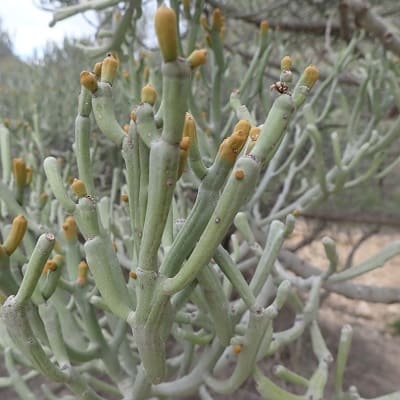
Euphorbia fiherenensis is a shrubby succulent tree to 6(-10) m tall exhibiting a corraliform branch structure, which is a xerophytic adaptation to the arid climate. The branches are about 6 mm in diameter and leafless.
Euphorbia fimbriata
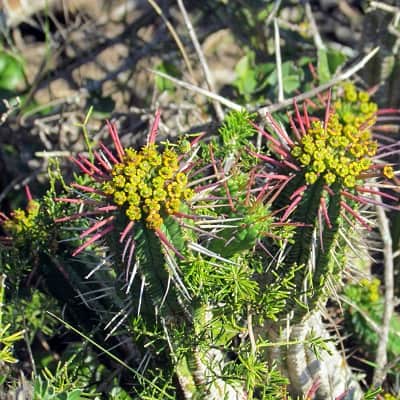
Euphorbia fimbriata is a dioecious succulent shrublets up to 30 cm tall (but up to 1 m high in the shade), simple, or frequently suckering from the base and branching irregularly.
Euphorbia flanaganii

Euphorbia flanaganii is a low, spineless, many-branched, succulent to 5 cm tall and 30 cm wide. It is commonly known as the Medusa plant because its prostrate, snake-like arms resemble locks of hairs. The central stem merges into roots forming a tuberous body (often called a caudex) with branches radiating from it.
If you look down into a large specimen you’ll see what looks like a sunflower; it’s another example of a Fibonacci spiral. A properly grown plant is a joy, especially when it is in flower, for then each snaky finger is covered with fragrant yellow flowers and the cluster is exquisite. The whole plant produces a caustic milky sap that can cause skin rash, itching and general discomfort.
Euphorbia fortuita
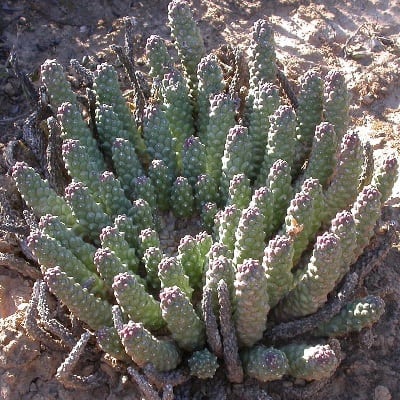
Euphorbia fortuita is a perennial succulent medusoid euphorbia, that has a tuberous main root merging into the main caudex, and stiff cylindrical branches usually about 10 cm long, but occasionally one will be twice as long. It is hermaphroditic (bisexual with male and female forms of flowers on the same plant.
Euphorbia francoisii
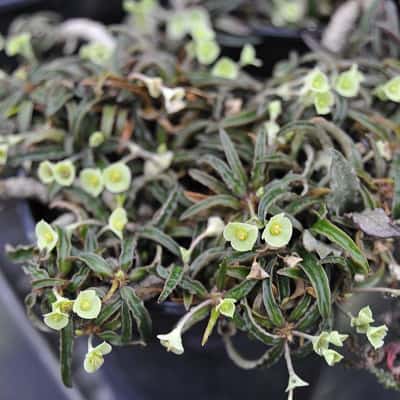
Euphorbia francoisii is a very variable caudiciform shrublet up to 15 cm tall with beautiful leaves coming in a dazzling array of shapes and colors that change with the seasons. If the unique leaf coloration and shape from one plant to the next were not enough the individual leaves on a single plant can vary in color and shape.
In its natural habitat, it is a seashore plant with underground stolons that does not make any stem growth above ground whatever apart from a rosette, flat on the ground. It is allied to such well-known caudex-forming euphorbia species as Euphorbia decaryi, Euphorbia cap-saintmariensis, Euphorbia cylindriflora.
Euphorbia fruticosa
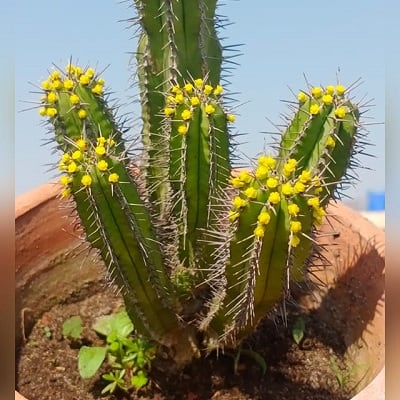
Euphorbia fruticosa is a succulent to woody cactus-like shrubs, branching at the base to form a spiny cushion of many twin-spined stems.
Euphorbia fusiformis
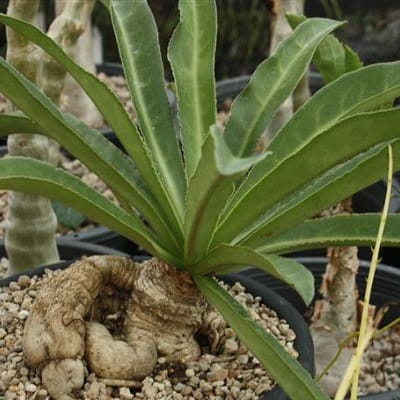
Euphorbia fusiformis is a tuber geophyte.
Euphorbia fusiformis var. khandallensis
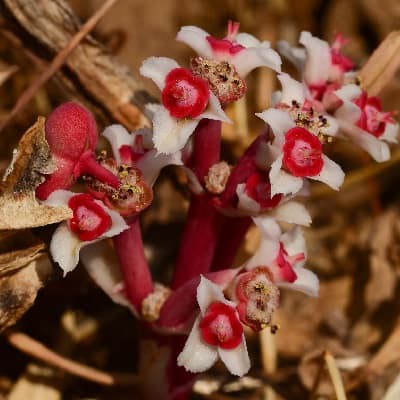
Euphorbia fusiformis var. khandallensis (formerly Euphorbia khandallensis) is a geophyte, polymorphic dwarf species similar to Euphorbia acaulis. It forms a substantial rootstock (caudex) that can grow to about 40 cm long and 10 centimeters in diameter, the whole aboveground plant to 15 centimeters height.
The green and purplish leaves are very attractive, appear during rains and fall off soon after they cease. The leaves are followed by a purplish inflorescence. The shape and size of the bracts is the feature most readily separating this plant from E. acaulis.
Euphorbia genoudiana
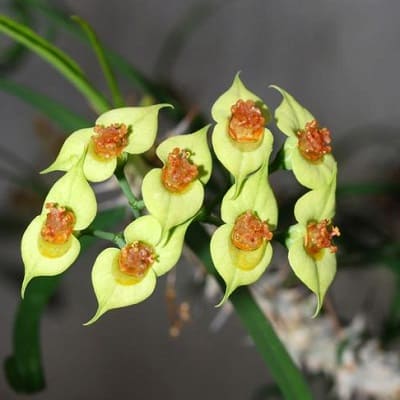
Euphorbia genoudiana is a small branched shrublet up to 25 cm high, with waxy slender stems heavily armed with waxy bone-colored thorns. In the upper regions of the stem, it produces grass-like leaves, up to 5 cm long and about 4 mm in width, giving the plant a most unusual appearance.
The inflorescence is fairly short, usually bearing two to four flowers (cyathia) with five glossy yellow-orange nectar glands round which are two green cyathophylls tapering away to a curly tip, adding to the weirdness of the plant’s appearance.
Euphorbia geroldii
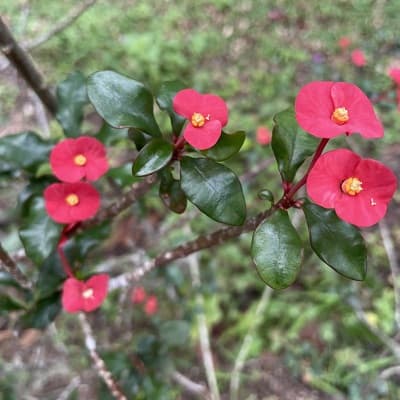
Euphorbia geroldii (a.k.a. Thornless Crown of Thorns) is a much-branched, unarmed, semi-succulent shrubs to 2 m tall. When E. geroldii flowers, the plant resembles Euphorbia milii with the large, red flowers and shiny, dark green succulent leaves.
Given the right conditions, E. geroldii produces a non-stop show of bright glowing red flowers throughout the year.
Euphorbia globosa
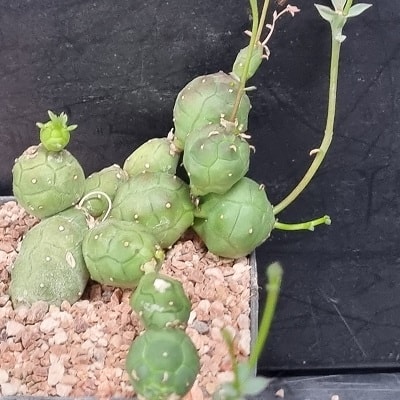
Euphorbia globosa is a dwarf spineless succulent composed of weird globular, segmented fingers off a caudiciform base, up to 8 cm tall. It forms thick mats of dwarf subshrubs up to 30 cm in diameter.
Euphorbia globulicaulis
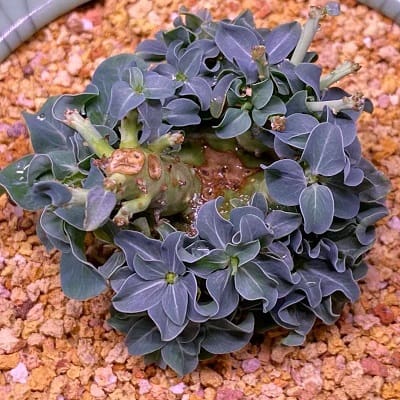
Euphorbia globulicaulis, reputedly the smallest of all succulent Euphorbias. In its natural habitat is a geophyte perennial herb 3-5 cm tall, with an underground subglobose fleshy stem less than 3 cm in section, which does not make any branch growth above ground whatever apart from a leaf rosette, flat on the ground.
Euphorbia gorgonis
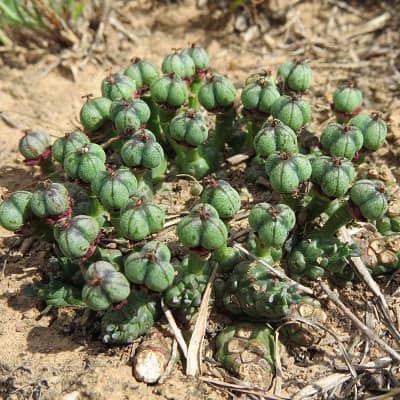
Euphorbia gorgonis is a spineless, small growing, species of the ‘medusa head’ type of euphorbia. It has a deep taproot that merges into a broad subglobose main stem (caudex), which bears a compact crown of short radiating branches in 3–5 series around a branchless flat or depressed central area.
It is a choice species, much prized by collectors because of its symmetrical form and neat habit. It is easily distinguished from its allied species because of its small size and dark red or brown glands (yellow or greenish-yellow in related species).
Euphorbia gottlebei
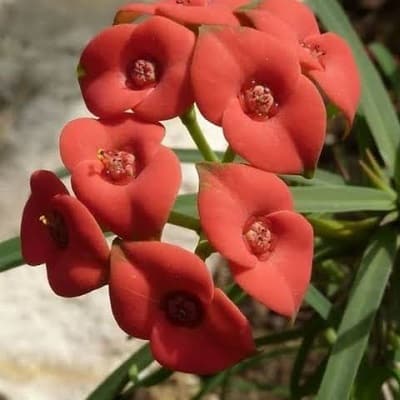
Euphorbia gottlebei is a very spiny shrubby Euphorbia looking like a miniaturized Euphorbia milii, but can still reach 1.5 meters in height.
Euphorbia grandialata
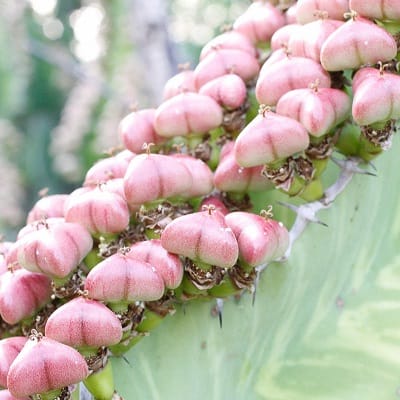
Euphorbia grandialata is a gorgeous and rare thorny columnar species with a solitary or branched trunk. Upright at first then branching from the base to form a spreading bush. Closely related to Euphorbia cooperi, it has reduced main stems and it is rarely higher than 2 meters whereas Euphorbia cooperi forms a definite tree.
The branchlets are deciduous and shed continuously as new ones are formed resulting in a bare trunk with irregularly spaced branch scars. The lower branches curve upward giving the tree the shape of a candelabrum.
Euphorbia grandicornis
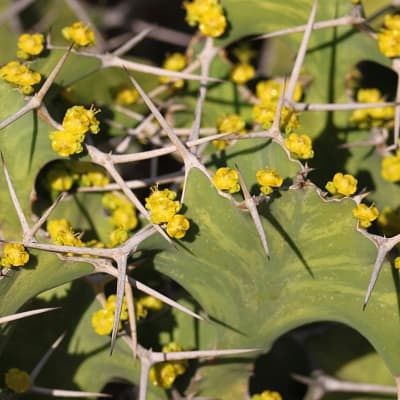
Euphorbia grandicornis is a great-looking upright multistemmed succulent shrub with strong spines resembling the shape of cows’ horns. It has great angular and zig-zag-shaped stems making it a good ornamental choice.
It has a close rigid bushy growth habit and can become enormous, often collapsing under its own weight eventually grows up to 2 m tall and about the same in width.
Euphorbia greenwayi
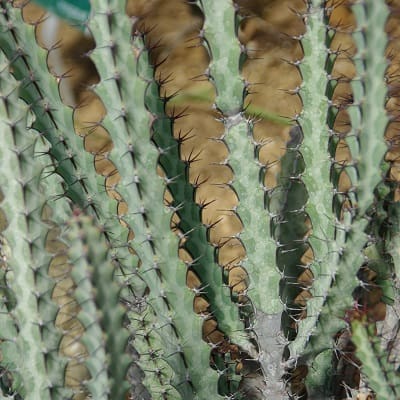
Euphorbia greenwayi is a basally branching succulent perennial to 30 m high with attractively marbled stems that trail along the ground without rooting. The four-sided branches are markedly variegated with vertical rainbow striations fading from green to blue to whitish-gray along the prominently and sharply-toothed spined margins outlined in reddish-brown.
The spines are thin and about 8-10 mm long. It produces unusual pinkish flowers in spring with long, thin red stigma lobes beautifying the plant.
Euphorbia groenewaldii
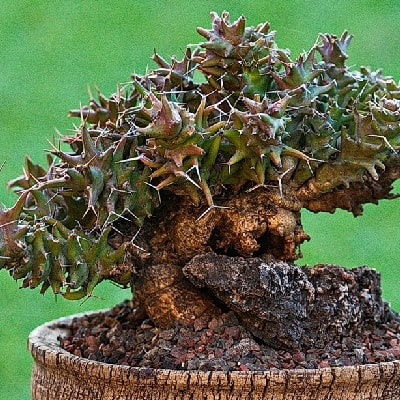
Euphorbia groenewaldii is a small spiny euphorbia topped off with 5-7 bizarre, twisted branches produced at ground-level from an underground caudex. The lax rosette of branches usually does not exceed 25 cm in diameter.
Euphorbia guentheri
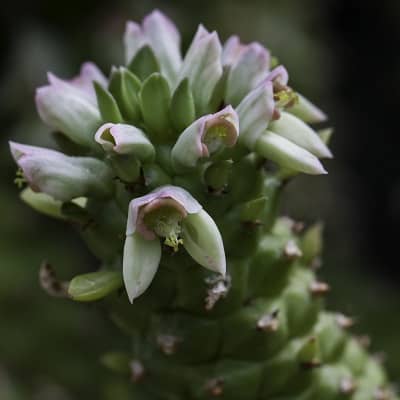
Euphorbia guentheri (Monadenium guentheri) is a stout perennial succulent herb with long, cylindrical stems, with prominent spine-tipped tubercles and fleshy sickle-shaped deciduous leaves. Flowers small with a red rim-like gland and enclosed in two fused greenish-white bracts with lovely purple mottling.
Euphorbia guillauminiana
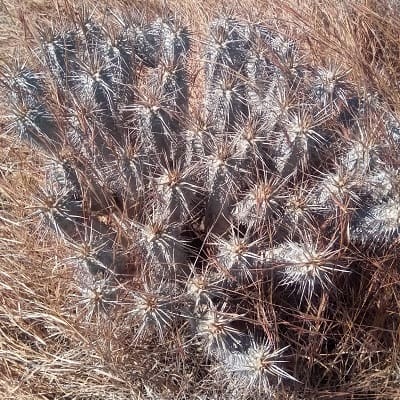
Euphorbia guillauminiana is a densely branched, hemispherical, succulent-stemmed shrub, up to 60(-100) m high, with thick, branches with spines arranged in 8 rows, numerous towards the apex. The leaves are crowded at the apices of the stems. The flowers are yellow or red.
Euphorbia gymnocalycioides
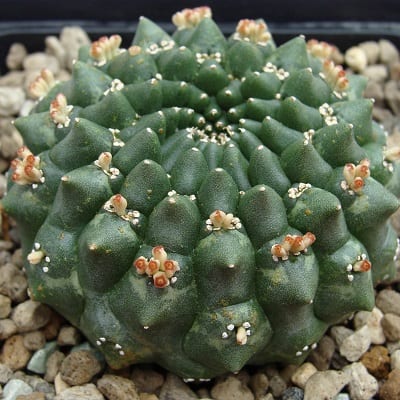
Euphorbia gymnocalycioides is a great-looking small succulent euphorbia with a deep green, knobby globoid body. It bears such a striking similarity to a genus in the cactus family, Gymnocalycium, that it was given the epithet “gymnocalycioides” (resembling Gymnocalycium).
This is a fine example of convergent evolution, a process in which the same adaptive traits evolve in distantly related species or groups as a response to similar environments (in this case, hot and dry deserts).
Euphorbia halipedicola
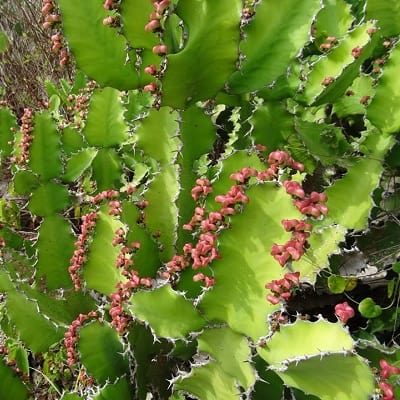
Euphorbia halipedicola is another of the Euphorbia cooperi-like plants with some subtle differences. It is a rare succulent shrub or small candelabra tree up to 4 m high, usually with a single trunk crowned with a whorl of segmented branchlets.
The branches do not split again, unlike the common tree Euphorbia. Old dead branches hang underneath the compact crown for a while. Over time all lower branches shed in a continual process leaving the top branches to accentuate the candelabra form.
Euphorbia hamata
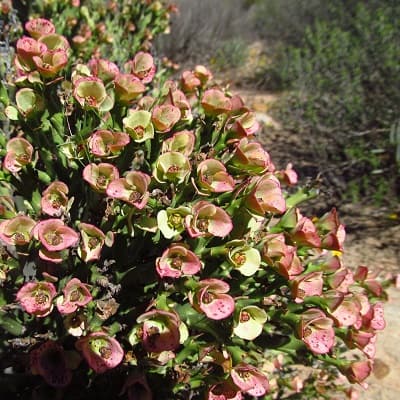
Euphorbia hamata is a thornless low-growing succulent, bushily branched from the base, sometimes forming large dense twisted masses 30(-45) cm high and 45 cm in diameter with small green to reddish flowers at the growing points. It is dioecious (unisexual).
Euphorbia handiensis
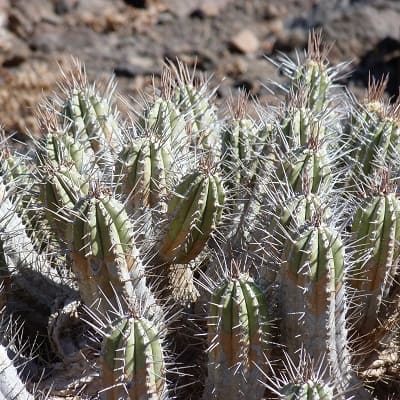
Euphorbia handiensis is a small clumping, columnar cactus-like shrub up to 1 m tall with sparse, long white spines, branching near the ground and branching forming relatively large specimens with age. Euphorbia handiensis is recognized as one of the rarest euphorbias under cultivation today.
The inaccessibility and limited area of its habitat, together with the slow growth of seedlings will keep this species always among the rarer euphorbias.
Euphorbia heterochroma
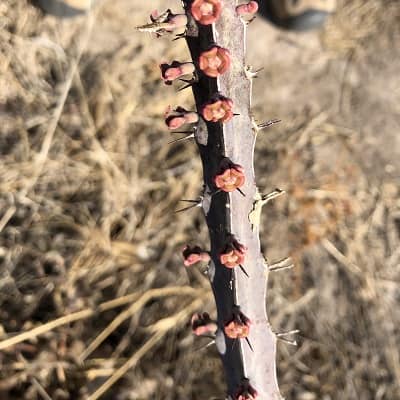
Euphorbia heterochroma is a small cactus-like spiny succulent shrub up to 2 m tall. The thin branched stems are attractively marked and may or may not have thorns. The species is very distinct from all those most nearly allied to it and easily recognized by its long-exerted small capsule.
Euphorbia hofstaetteri
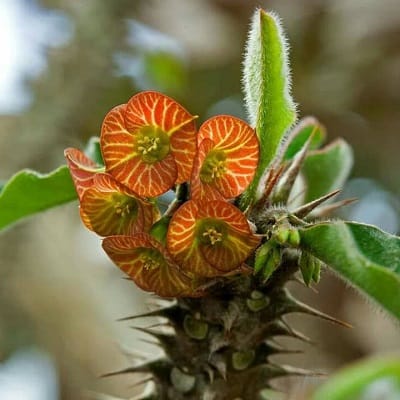
Euphorbia hofstaetteri is one of the thicker stemmed species belonging to the Euphorbia milii group. It is a remarkable shrubby Euphorbia to 70 cm tall, that has velvety leaves with a hint of a red margin.
The stems of this shrubby species are swollen at the base and are densely covered with spines. The flowers ( cyathia) are yellow-green with decumbent, red-brown striped, green cyathophylls (petal-like bracts).
This Euphorbia resembles Euphorbia croizatii, which comes from the extreme south between Ambovombe and Ifotaka, or Euphorbia rossii from the Mangoky river, which has a similar spination.
Euphorbia horombensis
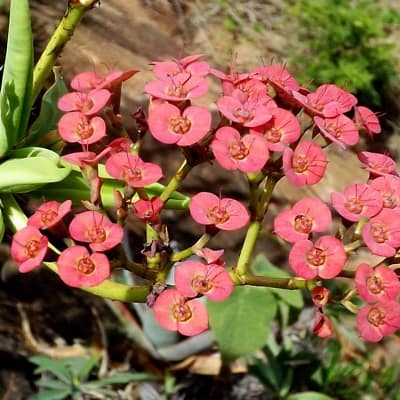
Euphorbia horombensis is a laxly and irregularly branching, xerophytic shrub with a spiny succulent stalk of the Euphorbia milii group, 1 to 1.5 m high.
It is similar in growth habit to Euphorbia milii var. breoni but differs from it in the shape of the spines, which are flattened base, in the densely branched inflorescences and in the smaller, reddish-brown cyathophylls (specialized leaves that surround the cyathium and give an overall flower-like appearance to the whole).
Euphorbia horrida

Euphorbia horrida is a spiny succulent shrub with irregular basally clumping stems. In age, it will form tight clumps of upright columns up to a meter wide that closely resemble some cactus species. It also has clustered crowns of somewhat ferocious spines much like the true cacti.
Euphorbia horwoodii
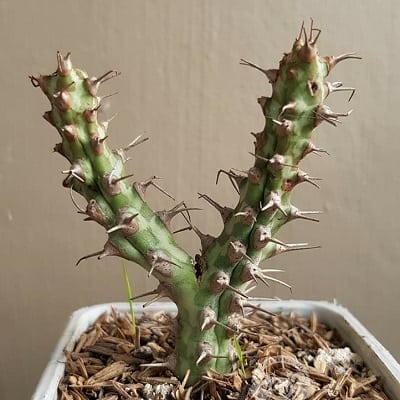
Euphorbia horwoodii is really a nice looking dwarf fibrous-rooted succulent that in the juvenile stage forms a sphere with completely reduced branches and form compact side-arms later as it gets old. Mature plants about 5 cm high and 12 cm in diameter.
But rarely cultivated plants on a graft retain their incredibly compact, highly evolved habit and often become almost a thorn bush with long messy side branches up to 30 (or more) cm in diameter. There seem to be several quite different-looking clones known in cultivation.
Euphorbia inaequispina
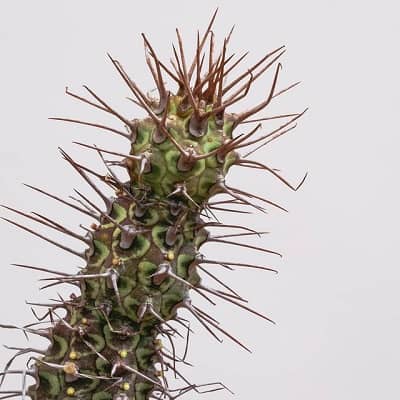
Euphorbia inaequispina is a dwarf and branching perennial succulent, leafless, and very spiny. The cylindrical stems, crowded shields, and long unequal spines, readily distinguish this from all other known species except Euphorbia ellenbeckii, from which it differs in the spine-shields not being 3-lobed, and an entire absence of a pair of prickles at the base of the spines.
Euphorbia inermis
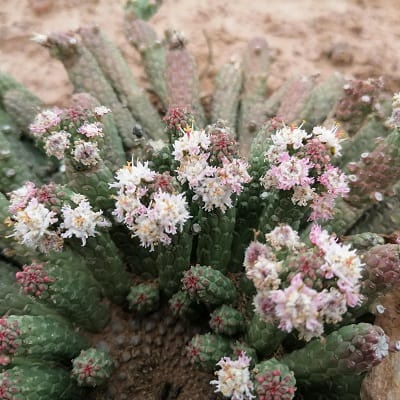
Euphorbia inermis is a many-branched medusa-form euphorbia up to about 50 cm in diameter with branches radiating like fingers from a central stem, continued below ground as a large fleshy tuber. Euphorbia inermis is monoecious.
A properly grown plant is a joy, especially when it is in flower, for then each short, erect finger is covered with fragrant, pure white (or yellow) flowers that look like snow crystals and the cluster is exquisite.
This is one of the caudex-forming Euphorbias, very similar to Euphorbia esculenta and Euphorbia caput-medusae. If you look down into a large specimen you’ll see what looks like a sunflower; it’s another example of a Fibonacci spiral. The whole plant produces a caustic milky sap.
Euphorbia infausta
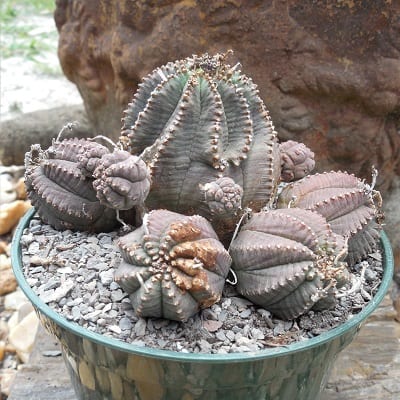
Euphorbia infausta is a dioecious small species that offsets from the base. The plants in the wild differ from one population to another, but also from one plant to another.
Euphorbia ingens
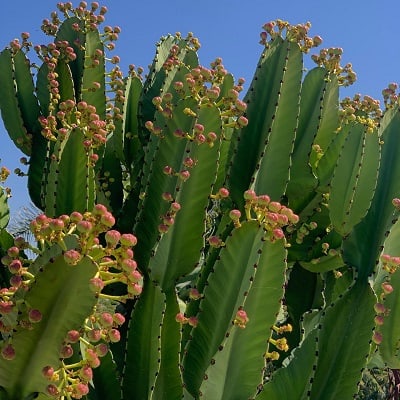
Euphorbia ingens (Giant euphorbia) is a spiny, succulent medium-sized to large tree 4–12(15) m tall, with a sturdy main stem and a massive dark green crown branching in a broadly obconical manner or in the shape of an over-sized egg-cup and not distinctly candelabra-like.
Euphorbia ingens is very similar to Euphorbia candelabrum from the Horn of Africa and eastern Africa and may be conspecific. The branches of Euphorbia ingens are usually more distinctly and shortly segmented, the teeth along the angles are usually further apart and the branch tips bear fewer inflorescences.
Euphorbia itremensis
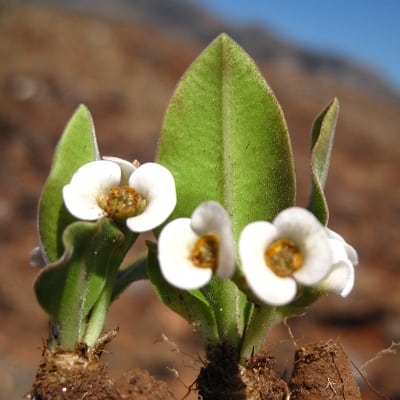
Euphorbia itremensis is a succulent geophyte plant that grows a subterranean napiform tuber producing several branches often strangely twisted and bent. In habitat, only the rosettes of leaves appear on the surface, but the pachycaul root can be deeply buried in the sand. Each rosette leaf corresponds to the apex of a stem.
The flowers of Euphorbia itremensis are said to be cream faintly tinged pinkish, but you can find anything from pure white to bright pink. The two-color forms coexist in the same habitat, and pale pink intermediate forms do occur.
Euphorbia jansenvillensis
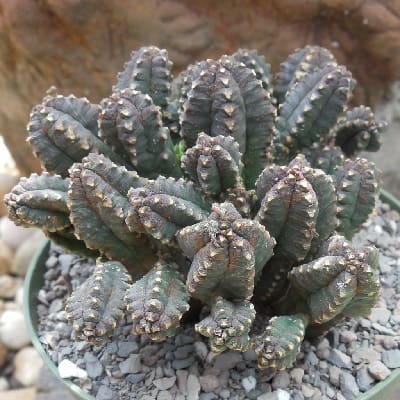
Euphorbia jansenvillensis is a succulent dioecious shrublets with waxy, tubular succulent stems that hug the ground and propagate by stolons.
Euphorbia kalisana
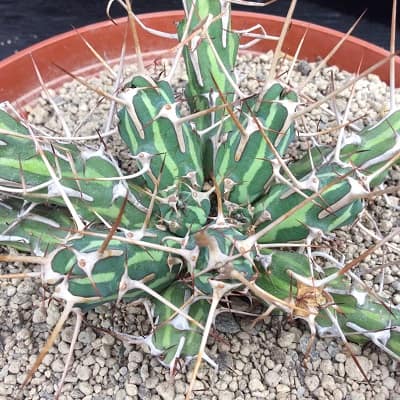
Euphorbia kalisana is a perennial medusoid succulent euphorbia forming spiny mounds to 1-2 m across, with sprawling cylindrical branches spreading from a thick central stem broader than high.
The stems showing dark/light green longitudinal stripes are bears single long spines. The cyathia are yellow. Euphorbia kalisana is strictly related to Euphorbia triaculeata.
Euphorbia klotzschii

Euphorbia klotzschii is an annual herb with leaves showing a certain degree of succulence. When the plant blooms the foliage often becomes tinged with dark red or purplish hues.
Euphorbia knobelii
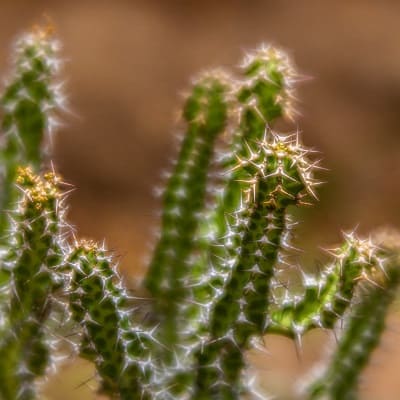
Euphorbia knobelii is a compact, shrubby, succulent Euphorbia from the Northwest Province of South Africa 70-100 cm tall. The short main stem has many branches at ground level, which are arcuate.
It is a very attractive plant with a striking coloring of alternate dark- and yellowish-green markings on the branches and paired dark spines. This could be the reason why it is also sought after by collectors. The flowers are yellow, vertical, with a short peduncle, 3 per flowering eye, and the overall effect is fairly spectacular.
Euphorbia knuthii
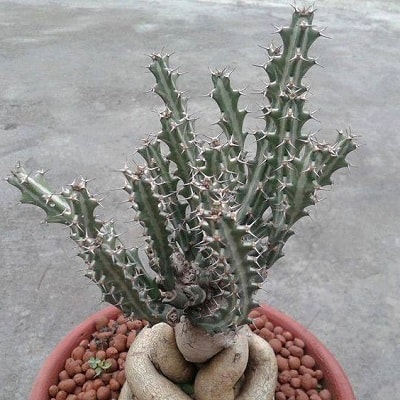
Euphorbia knuthii is a dwarf spiny succulent shrublet with a tuberous main root, which continues into a serpentine caudex, freely branched from the top. It is sometimes accompanied by a number of underground rhizomes. It is closely allied to Euphorbia squarrosa, and Euphorbia Schinzii.
Euphorbia labatii
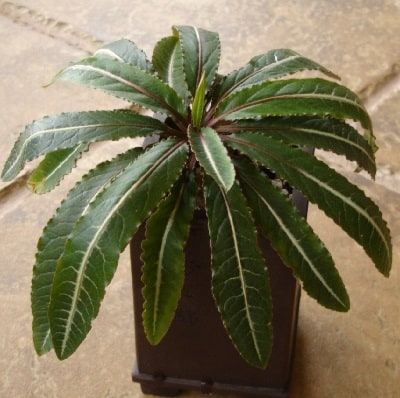
Euphorbia labatii is a geophyte, polymorphic dwarf species similar to Euphorbia moratii. It forms a substantial caudex that can grow to about 4 centimeters in diameter, the whole plant to 25 centimeters in height.
The crown of leaves is preceded by a ring of small pinkish-white, green-yellow or coppery flowers. The leaves are attractive, elongate green on top with a light center rib, burgundy underneath and wavy, crenate margins.
Euphorbia lactea
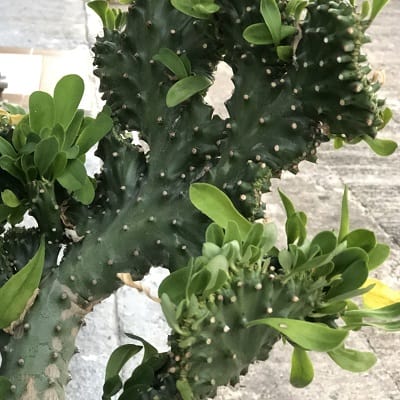
Euphorbia lactea is a tall, dark-green, many-branched, cactus-like shrub or small tree hairless throughout. It has a distinctive silhouette and can grow 3-6 m tall (or more) but rarely does in cultivation.
Euphorbia lactea is one of the most common succulent euphorbias in cultivation, but highly variable with several forms and hybrids making precise descriptions of it difficult.
Variegated and crested Euphorbia lactea is a popular subject for grafting; prized specimens are intricately convoluted and blend creamy white with shades of green and pink.
Euphorbia lactea cv White Ghost
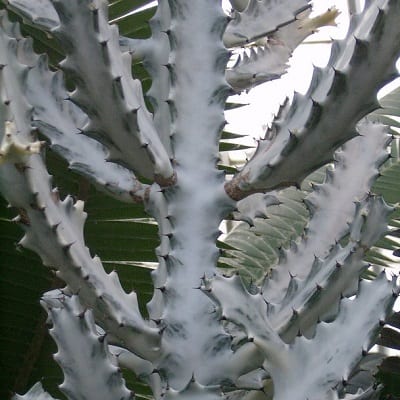
Euphorbia lactea cv White Ghost is a striking and very popular cultivar lacking in most of the chlorophyll-bearing tissues of its green counterpart. This Euphorbia doesn’t even look like a real plant and has an overall creamy white or greyish coloration.
Triangular stems grow in dense candelabra form with distinctive silhouettes and grow up to over 3 meters.
Very good in dry indoor situations, it is a much hardier plant than usually listed that does fine on its own roots. It and can also be grown outdoors in warmer climates even to full sun, though probably morning sun would be the most ideal situation.
It is a relatively slow grower, at least compared to the ‘regular’ form of Euphorbia lactea It is a beautiful plant that makes an incredible landscape plant.
Euphorbia lamarckii
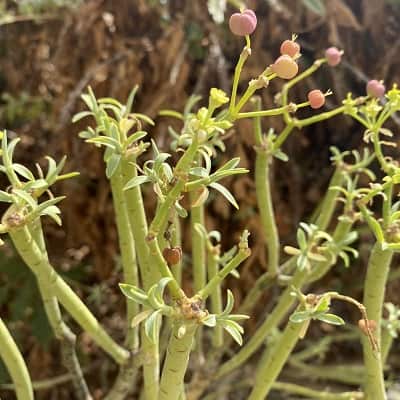
With a height of 0.8-2.5 meters, Euphorbia lamarckii is one of the largest Canarian spurges that form large shrubs or small trees with woody trunks. It belongs to the group of endemic shrub species.
It differs from other species by its pedunculated, umbelliform and usually compounds inflorescences, yellow-greenish in color and because the floral bracts fall off before the fruit ripens.
The yellowish-green floral bracts and narrow lanceolate leaves with rounded tips are very similar to the king Juba spurge (Euphorbia regis-jubae) that spread on the eastern islands, but their distributions do not overlap.
Euphorbia lambii
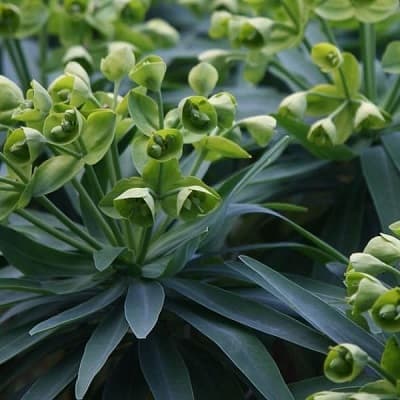
Euphorbia lambii is a shrubby succulent tree native to the Canary Islands. It can grow to a height of 6 to 10 feet. It has long, woody stems and branches. Thin dark green leaves grow in a rosette at the ends of upright branches.
Euphorbia ledienii

Euphorbia ledienii is a succulent shrub freely branching from the base to form a very cactus-like plant up to 2 m high.
Euphorbia lenewtonii
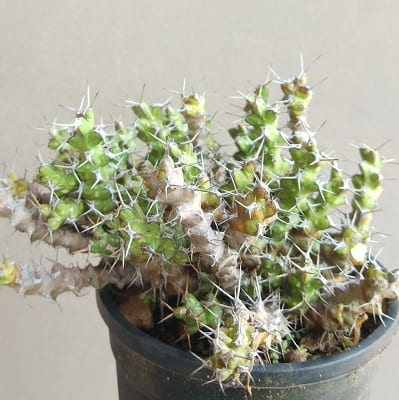
Euphorbia lenewtonii is a densely branching perennial herb, known from only one locality in Tanzania. It has green branches with some yellow highlights and forms tight cushions up to 10 cm tall and 50 cm in diameter, with the lower branches extended at ground level and rooting freely in contact with the soil.
In cultivation, the stems become more elongate but the plants still are relatively compact. The flowers (cyathia) are yellow.
Euphorbia lomelii
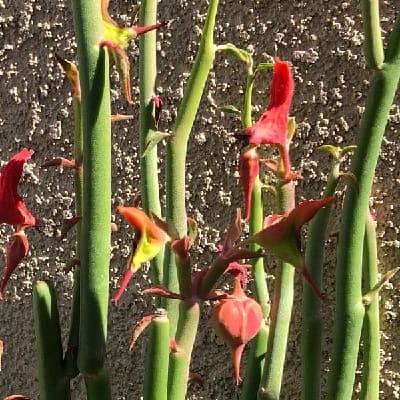
Euphorbia lomelii is a very distinctive succulent. It is mostly leafless and grows thick stems that grow to a height of 3 feet. It can grow taller if given proper shade. The stems start bending outwards in this case.
Euphorbia lophogona
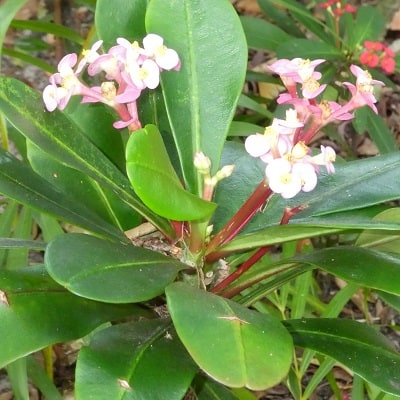
Euphorbia lophogona is a medium-sized ever-green or semi-deciduous succulent shrub, up to 120 cm tall.
Euphorbia loricata
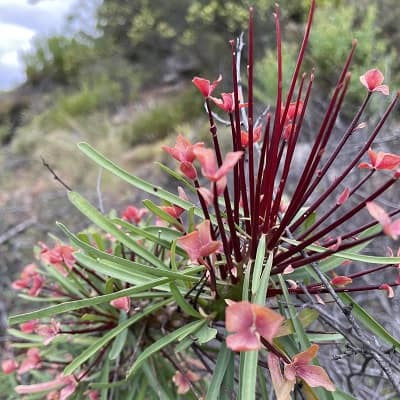
Euphorbia loricata is a slender leafy succulent with long, sharp thorns. In summer it is, of course, leafless.
Euphorbia lydenburgensis
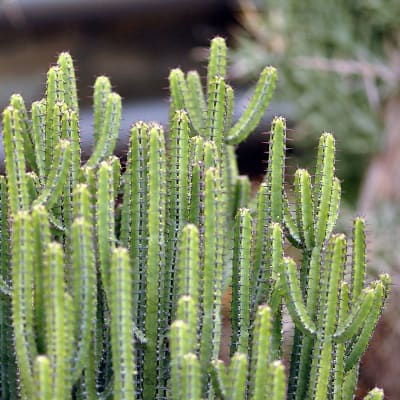
Euphorbia lydenburgensis is a much-branched, spiny, cactus-like, succulent shrub with characteristic thin branchlets. Lovely color combination when yellow flowers appear in spring. Its nearest relative is Euphorbia griseola.
Euphorbia mammillaris
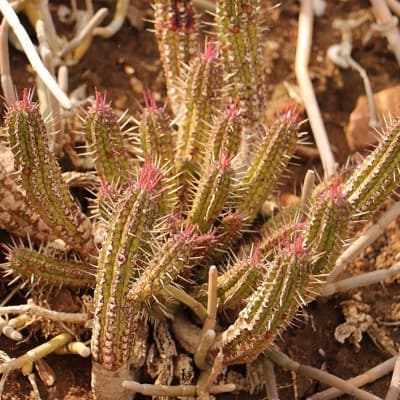
Euphorbia mammillaris is a short-stemmed shrublet producing a densely clustered mound. The stems have squarish or hexagonal tubercles in rows resembling “corn cobs”.
Euphorbia maritae
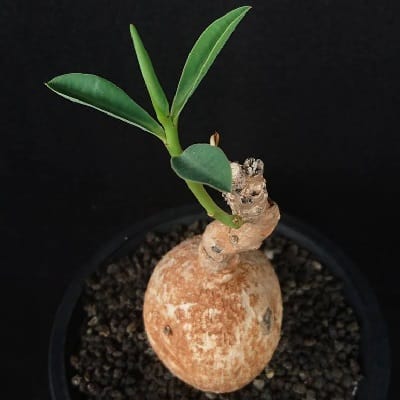
Euphorbia maritae is a perennial herb with a round tuber, related to Euphorbia platycephala and very similar to Euphorbia eranthes.
Euphorbia maromokotrensis
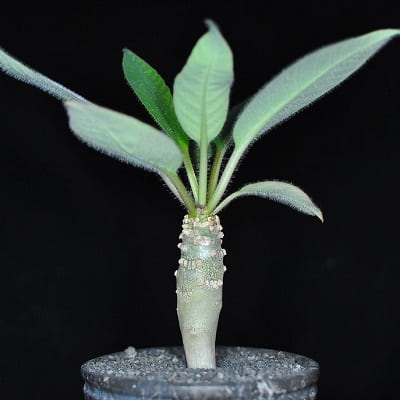
Euphorbia maromokotrensis, as is implied by the specific name, is a rare and localized species confined to the limestone hills of Ankarana in northern Madagascar. This is a new and poorly known caudiciform species of Euphorbia with thick fleshy stems, up to 45 cm tall and branching with age.
The deciduous leaves are ovate to sub-cordate, light green with neat brown veining and are shed at the beginning of the dry season. The top of the branches produces attractive brownish-green cones of petal-like cyathophylls (Coloured bracts around the cyathium).
Apparently, it blooms at the end of its growth cycle so that it loses its leaves. It is one of the nicest Madagascan Euphorbia, rarely found in specialized succulent collections.
Euphorbia meloformis
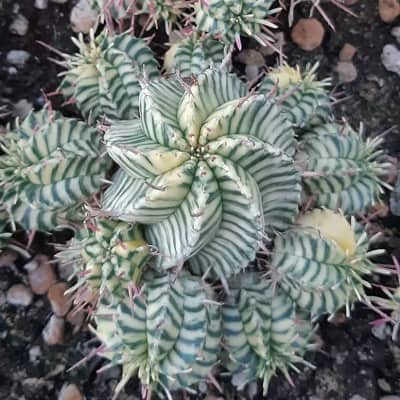
Euphorbia meloformis has round green and purple banded, spineless stems with 8 to 12 ribs. It occasionally offsets from the base. It is very similar in look to E. obesa, but with small yellow flowers on long peduncles which dry and persist on the plant after blooming.
It is quite common in cultivation, though less so than its relative E. obesa. Both species need male and female plants in order to set seeds.
Euphorbia micracantha
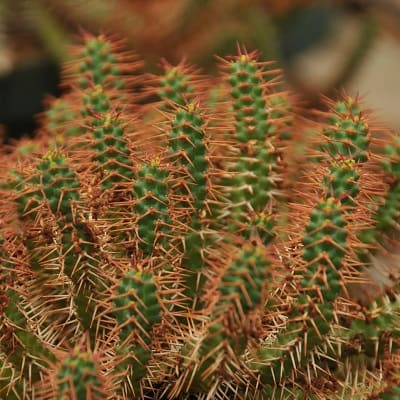
Euphorbia micracantha is a dwarf succulent perennial euphorbia with a long, fleshy rootstock (caudex) and a very short, thick primary shoot, at whose tip a wreath of 4 to 14 cm long leafless and spiny shoots emerge. The thorns are short, thin, and greatly flared. The cyathia are small, and the nectar glands are greenish-yellow.
E. micracantha is a bit like Euphorbia stellata but distinguished by its 4-angled branches and more slender spines.
Euphorbia milii
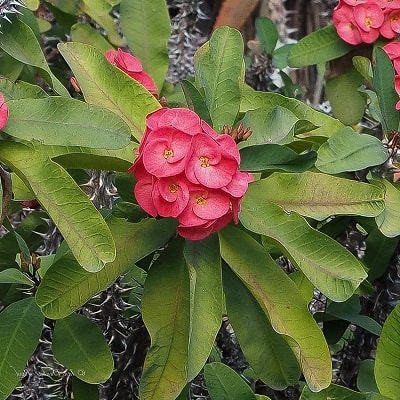
Euphorbia milii (crown of thorns, Christ plant, Christ thorn) is a thorny, much-branched, semi-succulent shrub to ca. 1.5-1.8 m tall, branches covered with spines. It is semi-prostrate or somewhat climbing and quickly forms a low dense hedge that can be easily trimmed without harming the plant.
It is widely grown in the tropics as an ornamental for the bright red bracts that resemble, from a distance, geraniums. Bracts of this beautiful shrub—which is seldom out of bloom—come naturally in bright red, but in cultivation, it is available in all warm colors, including red, yellow, coral, and cream.
Euphorbia milii cv. antafikiensis
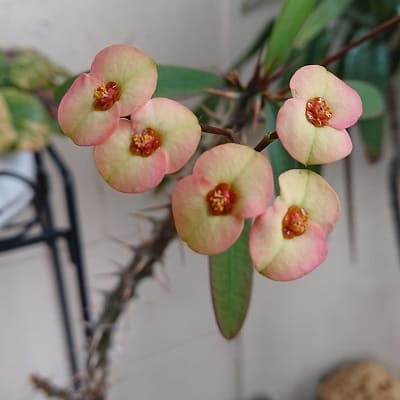
Euphorbia milii cv. antafikiensis has yellow-white cyathophylls with green cyathia, and dark green leaves. It is known in cultivation only.
Euphorbia milii f. lutea
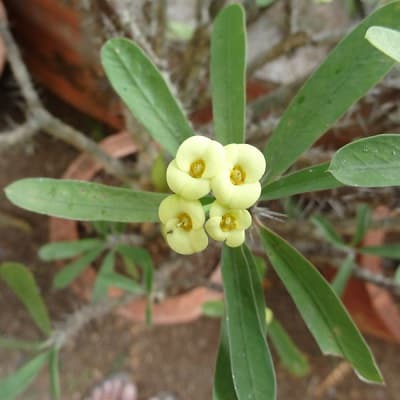
Euphorbia milii f. lutea (Yellow Crown of Thorns) is a thorny, much-branched, semi-succulent climbing shrub to ca. 1.5-1.8 m tall, branches covered with spines. It is semi-prostrate or somewhat climbing and quickly forms a low dense hedge that can be easily trimmed without harming the plant.
It is distinguished by small, variably yellow flowers, up to 1.2 cm broad, subtended by a pair of conspicuous petal-like bracts.
Euphorbia millotii
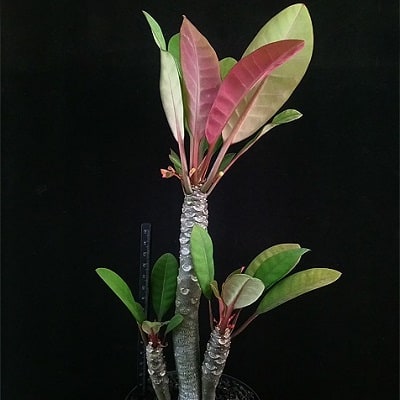
Euphorbia millotii is a unique charming succulent scrublets up to 80 cm tall with round, initially greenish-red, later grey, lignified branches. The cyathia (flowers) are nodding, encircled by the ample, dark, wine-colored cyathophylls, which unfold only slightly. The foliage, which appears after the bloom is green with rich purple undersides at first.
Euphorbia mitriformis
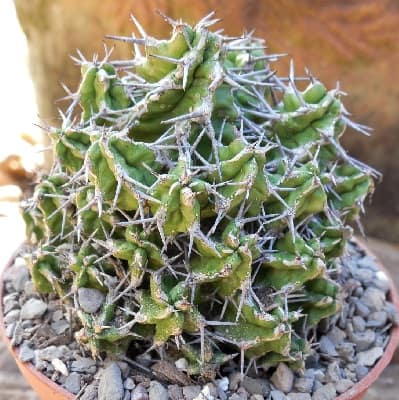
Euphorbia mitriformis is a low growing, dense, compact, clustering succulent that in nature forms impressive rounded or conical mounds up to 40(-100) cm tall and 1m wide. Each mound is composed of a lot of little heads of just 1 to 1.5 centimeters in diameter.
It is a relatively variable species. Some form dense cushions of very small branches up to 30 cm in height; others have fewer and longer stems, up to 1 m high.
Euphorbia monteiroi
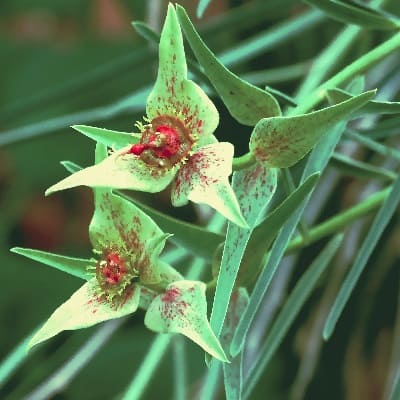
Euphorbia monteiroi is a perennial, succulent herb or shrubs to 1 m (usually less than 30 cm tall). This species is unique in several ways, it has a swollen “cabbage stump” stem from a woody rootstock. The leaves on this basal part are long and thin.
After the rain, the tuberculate stem produces a crown of thin, leafy, deciduous inflorescences with a small dark-red flower on the tips. The long peduncles (stems of the inflorescences) eventually wither and persist, as spines for several seasons, curving over the top of the plant and forming a useful canopy from the burning sun.
The flowers are borne on long, thin branches with leaves that gradually become shorter. The roots are occasionally rhizomatous, branching below ground to form spreading plants. White latex is exuded from points of injury anywhere on the plant
Euphorbia moratii
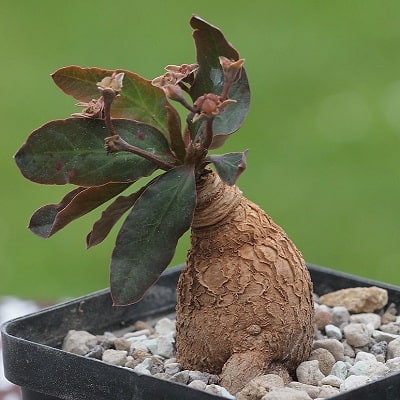
Euphorbia moratii is a geophyte, polymorphic dwarf species. It forms a caudex that can grow to four centimeters in diameter, the whole plant to twelve centimeters in height.
Euphorbia mosaica
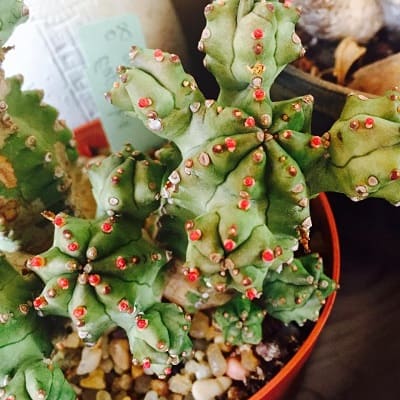
Euphorbia mosaica is a low, mound-forming succulent composed of rounded masses up to 8 cm in height and 15 cm in width, remembering a mosaic when seen from above. It is a slow grower.
Euphorbia multifolia
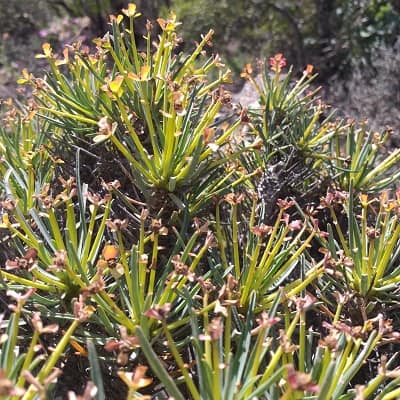
Euphorbia multifolia is a spineless perennial succulent-shrub, forming a green, raised leafy cushion up to 15(-30) cm high. During drought it can lose its leaves – otherwise, it is mostly evergreen.
Euphorbia multiramosa
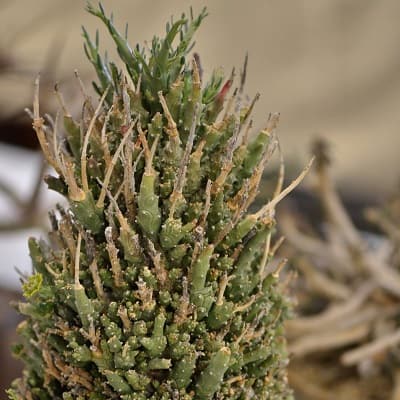
Euphorbia multiramosa is a dwarf, rather ugly-looking, irregularly shaped, succulent shrublet to 30 cm tall, with a deep taproot merging into a fat subglobose main stem. The whole stumpy body of the plant is covered with very numerous branches all over, except at a small central area at the apex.
The branches are short, branching, tapering to a long spine-like point which ultimately dries away, and are covered with very prominent elongated tubercles in spiral series. The flowers are dark cream-colored.
Euphorbia myrsinites
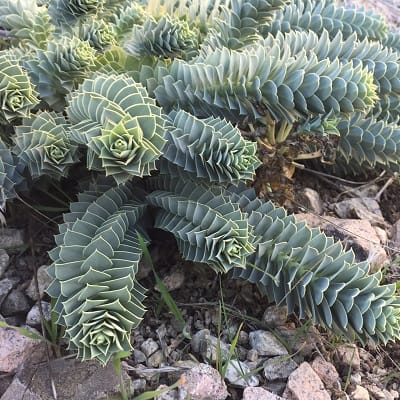
Euphorbia myrsinites, commonly called Euphorbia Donkey Tail, is a grayish-green, tufted, succulent herb, evergreen, perennial, (sometimes biennial). It has dense leafy, sprawling stems growing to 20-40 cm long. The leaves are spirally arranged, fleshy, pale glaucous bluish-green, 1-2 cm long.
The flowers are inconspicuous but surrounded by bright sulfur-yellow bracts. This species is widely cultivated as an ornamental rock-garden plant. The waxy, succulent leaves make Euphorbia myrsinites one of the most drought-tolerant of all hardy garden plants.
Euphorbia nadiae
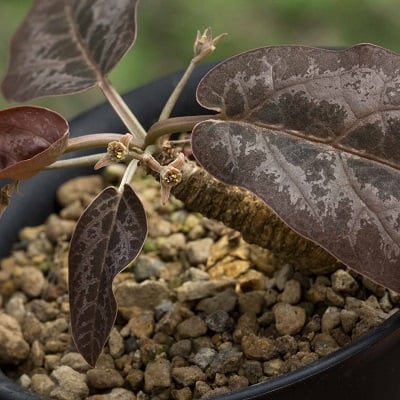
Euphorbia nadiae is a geophyte, dwarf species. It forms a caudex and has very beautiful brown leaves, but the flowers remain tiny.
Euphorbia najuneranatanii
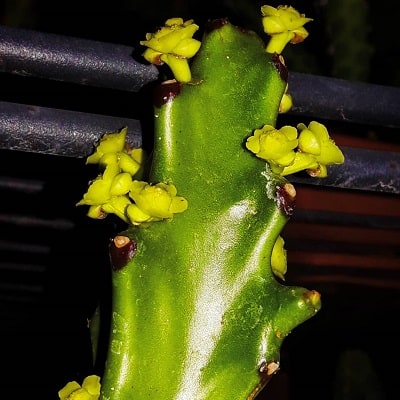
Euphorbia neohumbertii
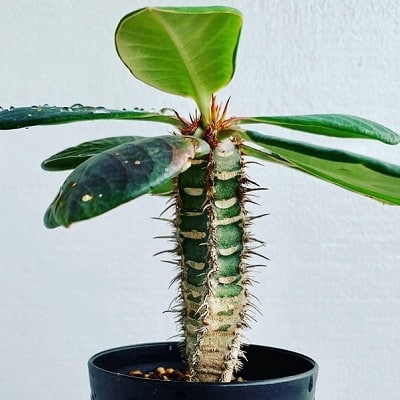
Euphorbia neohumbertii is a succulent originating from Madagascar. It is a very distinctive plant with a spiny, 4-sided stem that branches out at the top. The stems are upright and grow almost vertically.
Euphorbia neomontana
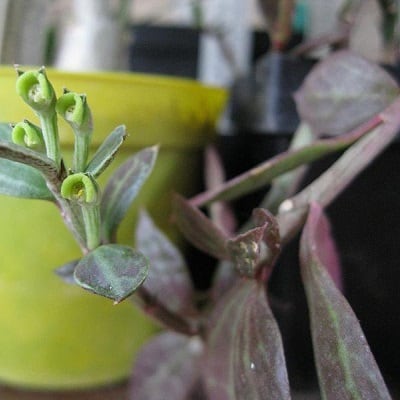
Euphorbia neomontana is a perennial succulent herb that belongs to that elite group of geophytes with the rhizome or caudex below ground in nature. It produces branched stems looking like a colony of twisting, snakes and succulent obovate leaves mottled in purple.
Euphorbia neorubella
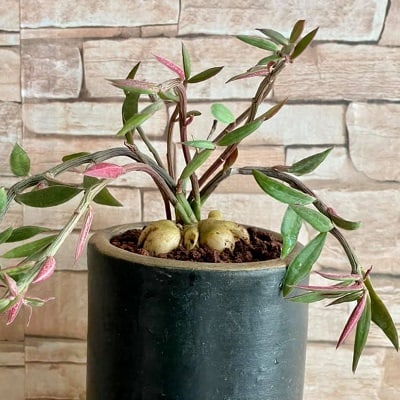
Euphorbia neorubella (Monadenium rubellum) is an odd caudiciform plant with dainty branched stems looking like a colony of twisting, light-green snakes and succulent lanceolate leaves dappled in purple.
This perennial, succulent herb is interesting not only because of its ‘round foot’, but also because it flowers pretty much year-round, and doesn’t seem to need a dormant period. This ‘round foot’ is where it stores its water reserves that are its stock for dry periods.
Euphorbia neostapelioides
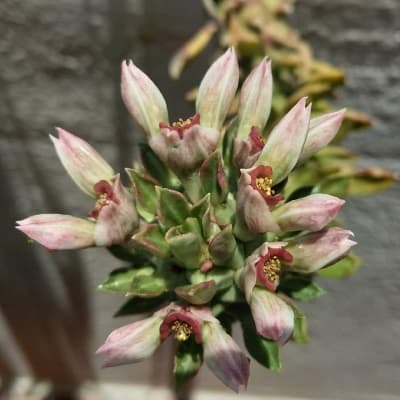
Euphorbia neostapelioides (aka Monadenium stapelioides) is a glabrous succulent perennial herb, branching at the base of a large fleshy rootstock and forming a domed cushion to 60 cm in diameter. This beautiful Euphorbia produces many multicolored stems. The stems tend to flop over and hang with this species.
The flowers have a bract cup that is white or light pink, they are small but interesting and showy when produced in large numbers. Leaves are produced at the growing point, but they last only one season. The leaves are succulent and shot through with purple-pink streaks through the light green background, making this a beautiful species.
Euphorbia neriifolia

Euphorbia neriifolia, the “oleander-leafed spurge,” is a large much-branched xerophytic fleshy shrub, which sometimes grows into a small tree 2-6 meters, or more in height with rounded branches.
Euphorbia obesa

Euphorbia obesa is a highly succulent solitary plant without spines or leaves that looks like a green-brown soccer ball but will sometimes ‘branch’ or sucker, creating very odd-looking clusters of spheres.
Varieties of Euphorbia obesa:
Euphorbia symmetrica
Euphorbia officinarum
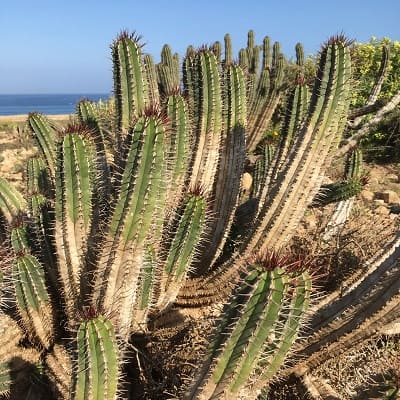
Euphorbia officinarum is a tufted monoecious succulent shrub 1-1.5 meters tall, with erect stems 9-13 ribbed.
Euphorbia olowaluana
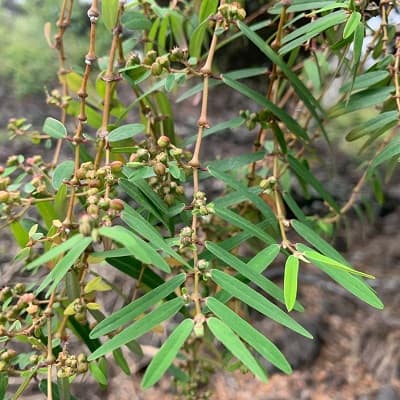
Euphorbia olowaluana, known in Hawaii as ‘akoko’, is a tree up to 9 m tall. The specific epithet olowaluana is named after Olowalu, West Maui, one of the locations where this species is found.
Euphorbia ornithopus
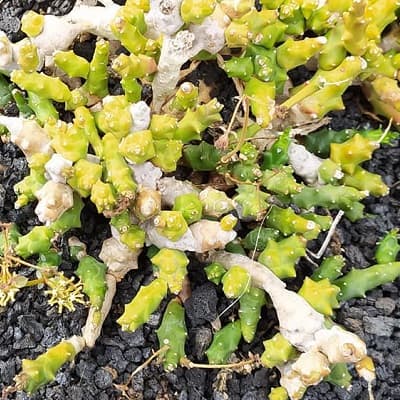
Euphorbia ornithopus (the bird’s foot Euphorbia”) is a succulent, spineless, euphorbia, irregularly ramified near the ground with a nice caudex. Its short-cylindrical, phallus-like, branch segments are disordered and lying on the ground, formed by sharp, conical tubercles, some are underground sprouting a decimetres away from the parent plant.
It has an inflorescence in the form of cyathium (apparently a single flower, actually several). The species reaches 7.5 cm high (excluding the peduncles) by 1-meter spread. The gnarled rhizomes and aerial stems are very similar to those of the closely related Euphorbia tridentata.
Euphorbia pachypodioides
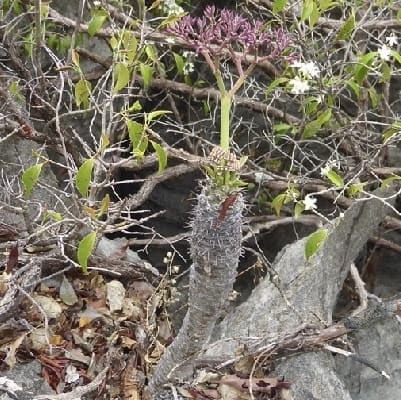
Euphorbia pachypodioides is a highly desirable species with a high horticultural appeal. It forms short pachypodium-like stems with attractive bright red cyathia at the top and bright frosted blue leaves.
Euphorbia pentagona
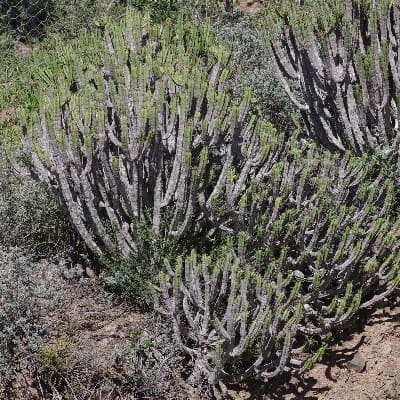
Euphorbia pentagonal is a compact perennial cactus-like shrub with prominent ribs that freely branch above and can grow 2.5- 3 m tall.
Euphorbia perrieri
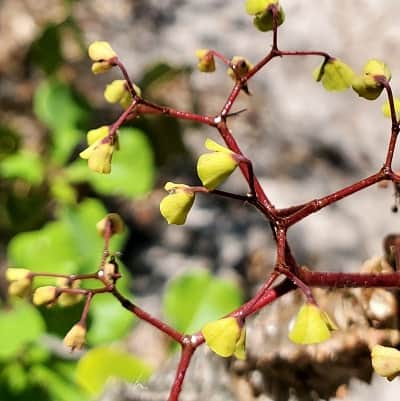
Euphorbia perrieri is a few branched succulent shrubs up to 2 m high. Its spiny branches are arranged in spiral rows.
Euphorbia petraea
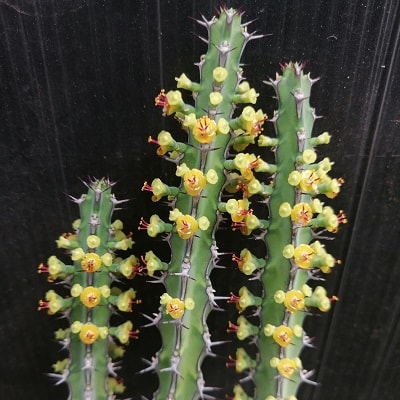
Euphorbia petraea is a spiny, hairless, decumbent spreading succulent shrub, densely branched from the base, sparsely branched above, to 60 cm tall.
Euphorbia phillipsiae
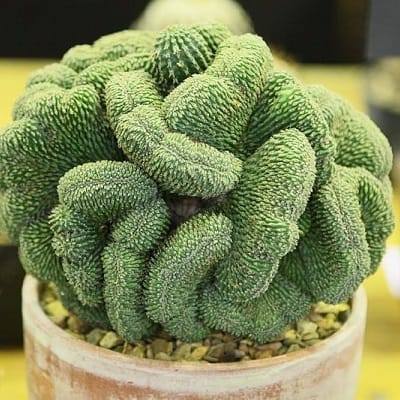
Euphorbia phillipsiae is a compact cushion forming succulents. It is of small growth and is a most interesting plant, one of the rarest of the genus.
Euphorbia phillipsioides

Euphorbia phillipsioides is a small spiny succulent about 5-15 cm tall, that forms clumps up to 10 cm in diameter. It branches profusely at the soil level.
Euphorbia phosphorea
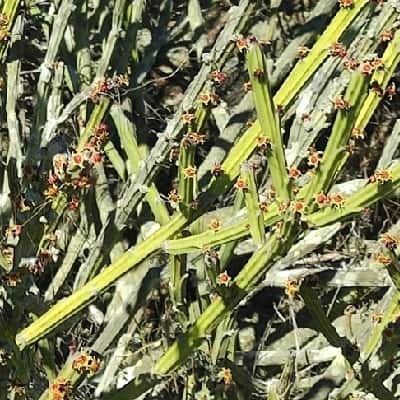
Euphorbia phosphorea is an essentially aphyllous shrub or small tree with a short trunk that divides a few centimeters above the ground into many strongly ribbed branches which grow in grand profusion, forming a huge crown.
It attains a height of up to 6 meters when growing amongst other vegetation growing around it but usually stays with an average height of 2 meters. The plant shares its general habit of growth with Euphorbia pteroneura.
Euphorbia pillansii
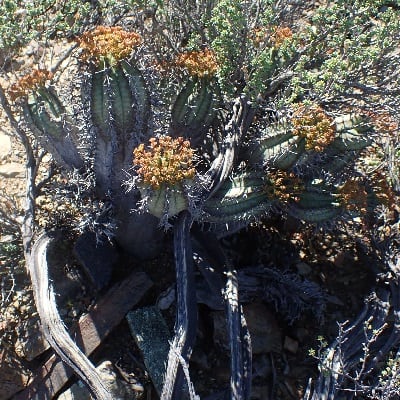
Euphorbia pillansii is a unisexual (dioecious) columnar Euphorbia branching from the base and above to form small clumps
Euphorbia piscidermis
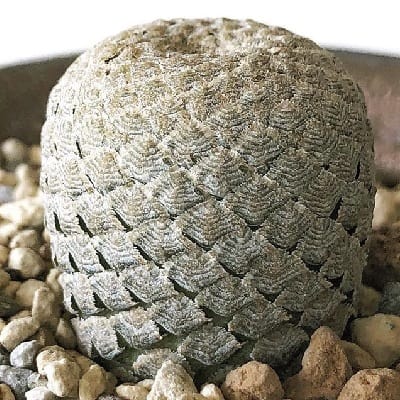
Euphorbia piscidermis (a.k.a. Fish Skin Euphorbia) is an attractive dwarf succulent Euphorbia covered with characteristic “fish scales” that look something like a small golf ball, no one would suspect it of being a Euphorbia when it is not in flower.
E. piscidermis has a very unique look and is amongst the most desirable of all collectors’ plants.
Euphorbia planiceps
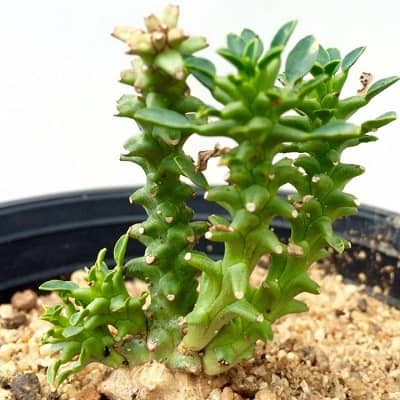
Euphorbia planiceps is a low, succulent shrublet developing from an underground caudex (thickened stem) that is a continuation of the tuberous main root, divided below into carrot-like or longer roots.
On the head and at the sides the there are a great number of branches that re-divide, forming a dense congested mat (up to 300 mm in diameter) which appears flat on the soil surface.
This ‘flat head’ is due to the continual contraction of the branches downwards, a feature that controls water loss in the arid areas in which it lives. Unlike the related species here it does not develop rhizomes.
The plant is spineless but the peduncles however persist for a year or longer and are 1.5-2.5 mm long. Its remarkable flowers (cyathia) possess at the outer edge of the glands 3-4, conspicuous, teeth-like processes commonly referred to as fingers.
Euphorbia platyclada
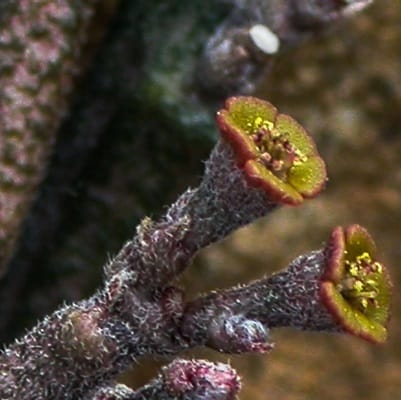
Euphorbia platyclada is a fleshy succulent plant with weird flattened mottled red-brown stems radiating from a raiseable heavy rootstock… nothing green about it.
The branches are very interesting, unique, with an irregular scab-like texture, and look dead, or at the very least zombified. These branches are splayed out with fingers dangling like dead weights.
Euphorbia poissonii
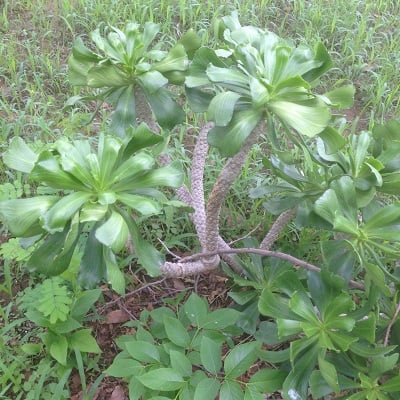
Euphorbia poissonii is an erect much-branched succulent shrub 1.2-2(-3) m high, with candelabriform branching with one to several columns and topped with large green leaves during the growing season, occasionally sub-spiny.
Euphorbia polyacantha
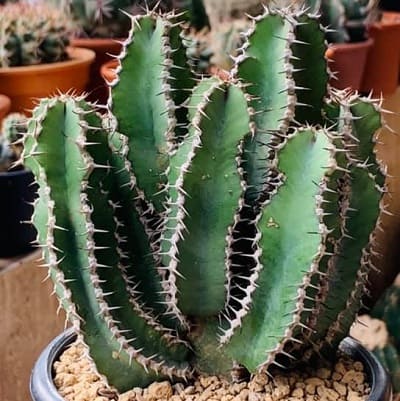
Euphorbia polyacantha is a succulent leafless spiny shrub 1-1.5 m high, occasionally to 2 meters, that is broader than high, with little or no clear trunk and numerous, and densely erect branches forming a dense rounded or almost flat crown.
The flowers (cyathia) are small, yellow-green and grow from “eyes” exactly in between the spine pairs in the angles of stems.
Euphorbia polygona
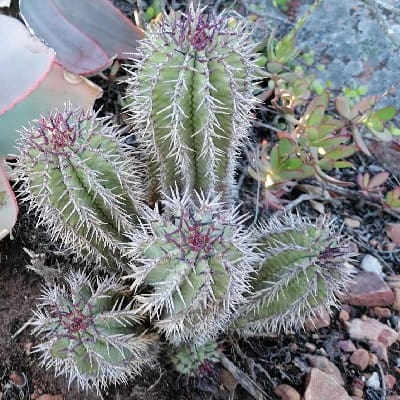
Euphorbia polygona is a spiny dioecious spurge with simple or basally clumping stems of glaucous gray-green with beautiful “heads” of dark purple flowers. These are very minute in themselves, but each is dotted with bright yellow stamens and pollen and the whole effect is very pleasing.
In age, it will form clumps of upright columns of unequal length up to a meter wide that bears a very close resemblance to the unrelated cactus. It is heavily armed with spiny protuberances (“peduncles”, otherwise known as persistent flower stalks), however, the spination is extremely variable some have lots of spines, and some have few.
Euphorbia primulaefolia
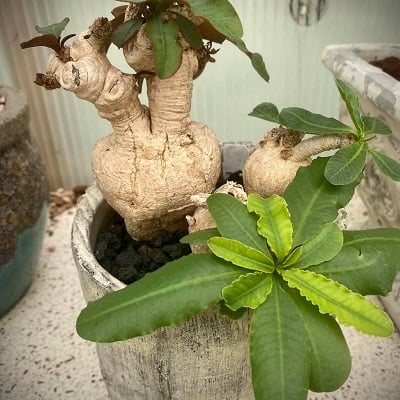
Euphorbia primulifolia is one of the true tuberous geophytes from Madagascar which aerial portions are reduced to a rosette of leaves from which emerge colored flower cups. The whole vegetative system is condensed to a large subterranean organ.
Euphorbia pseudocactus
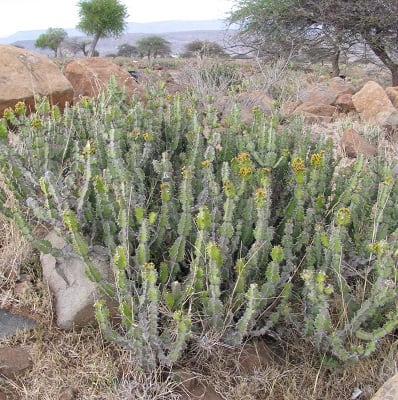
Euphorbia pseudocactus is a multi-branched, dwarf-stemmed succulent shrub that, as its name suggests, resembles a cactus. The stems often have distinctive yellow V-shaped markings. Plants eventually form large mounded clumps branching from the base and above, 60-120 cm tall and up to 2 m in diameter.
Euphorbia pseudoglobosa
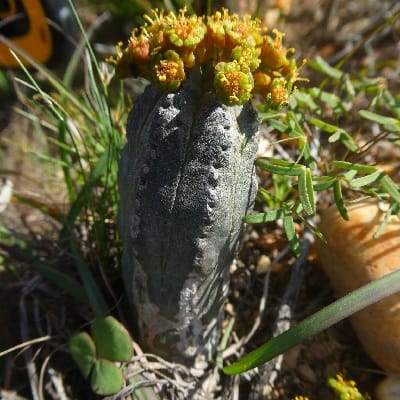
Euphorbia pseudoglobosa is a dwarf spineless succulent that looks like a cactus, eventually forming a subterranean caudex (often lifted up into view in cultivation for looks) It forms thick mats of dwarf spineless segmented stems up to 20 cm in diameter.
Euphorbia pseudoracemosa
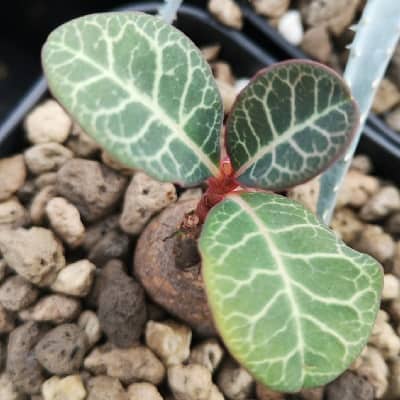
Euphorbia pseudoracemosa is a glabrous succulent geophytic perennial herb, with a cylindrical tuberous root, also called a caudex producing a woody subterranean stem to 6 cm long; annual stems to 7 cm tall topped with interesting olive green leaves with pearly white veins and a red underside.
Euphorbia pteroneura
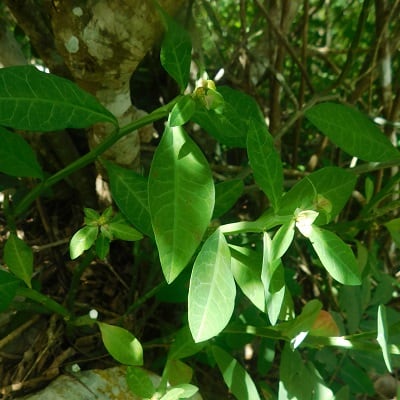
Euphorbia pteroneura is a Mexican semi-succulent species with pencil-like stems, showing the development of 5 or 6 distinct angles along the branches. It ramifies sparsely at the base from a short stem and above into several erect green stems, radiating out to form an open bush up to 50 (or more) cm high and as much or more in diameter.
The stems produce a few alternate deciduous leaves near the growing points and clusters of light-green cyathia tinged with pink during the early winter. E. pteroneura is 1 of only 4 succulent spurges known to occur in Mexico.
Euphorbia pubiglans
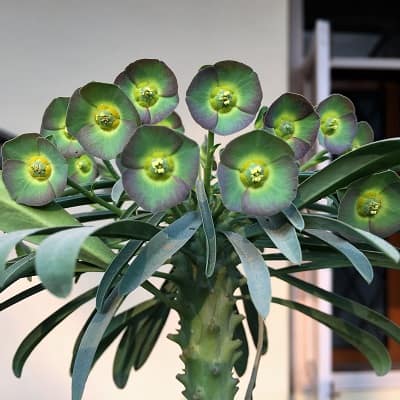
Euphorbia pubiglans is a stout succulent herb similar in habit to Euphorbia bupleurifolia but branching to form a rounded or conical shrub to about 30 cm tall. It can be distinguished from the latter by its taller habit, its persistent peduncles, and the bracts which surround the cyathia forming a circular plate 25 mm in diameter.
The stems are knobby, with spirally arranged tubercles. The linear leaves, whose blades are usually folded upwards are clustered at the stem tips. The three large, rounded bracts surrounding the cyathium are very striking in this species.
There are actually five subtending bracts, but two are hidden behind the larger ones. E. pubiglans is a pretty succulent that is seldom seen.
Euphorbia pulvinata
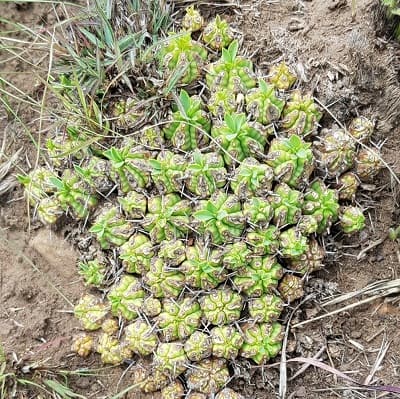
Euphorbia pulvinata is a low-growing clumping dioecious (having distinct male and female specimens) succulent, that in nature forms impressive giant pulvini (cushions), composed of several thousand little spiny heads.
On the ground, it makes a striking cushion up to 1.5 (or more) meters in height and across. Sometimes several plants are aggregated into masses up to three meters in diameter.
Euphorbia punicea
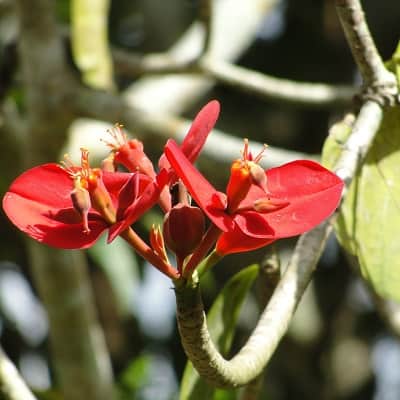
Euphorbia punicea is a remarkably fine species of euphorbia (spurge) relative of the common Christmas Poinsettia (Euphorbia pulcherrima). The small insignificant golden yellow flowers are surrounded by a very showy crown of flashy-red petal-like bracts, looking like larger flowers from a distance.
Unlike the poinsettia, this large shrub or small tree may flower year-round. The foliage is of a peculiar light green and is thickly set on magnificent light-colored stems.
Euphorbia quadrangularis
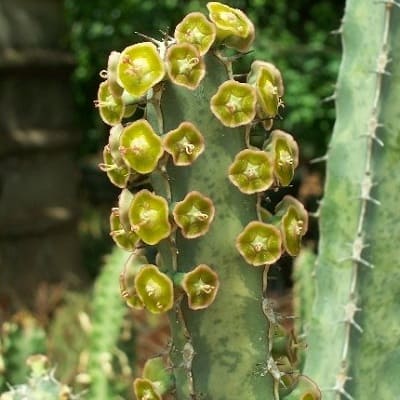
Euphorbia quadrangularis is a very sparsely branched succulent shrub 2 to 3.5 m tall, with branches spreading at right angles from the main stem with square and spiny stems that are beautifully variegated.
Euphorbia ramena
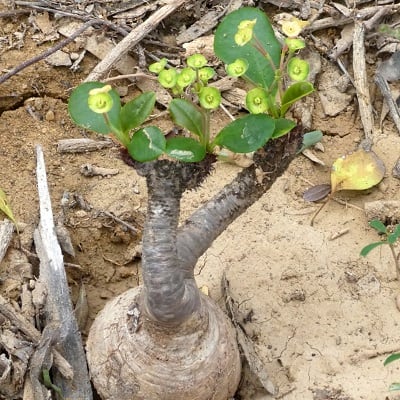
Euphorbia ramena is a geophyte that shows big contrast between the thinner branches and the thick caudex-like rootstock.
Euphorbia ramiglans
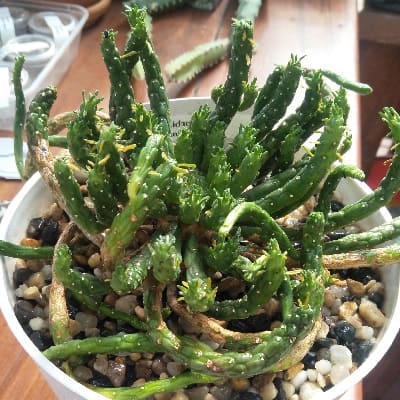
Euphorbia ramiglans is dwarf attractive species similar in habit to Euphorbia caput-medusae, but with shorter tuberculate branches which must arise from a sunken central body. It never exceeds 20 cm high and 50 cm in diameter (but usually stays smaller and almost completely buried in the sand).
The flowers (cyathia) are solitary at the ends of the branches and have much the same construction as those of Euphorbia tuberculata, with fingered glands, the yellow processes forked at their tips.
Euphorbia razafindratsirae
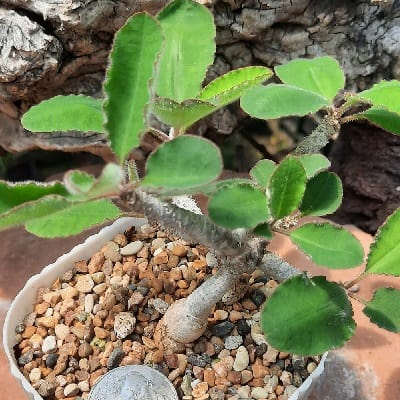
Euphorbia razafindratsirae is a choice miniature in the E. milii group. It forms a dwarf shrublet with horizontally spreading branches with a surprisingly ample caudiciform base. The plant is a low grower with pencil-thick branches bearing tiny spines.
When in leaf, the foliage is oblong, with wavy margins and slightly pubescent. The chartreuse to reddish cyathia, similar to those of the related Euphorbia hoffstaeteri, are formed during winter dormancy when the plant is leafless.
In summer it is partly shrouded by the pubescent, undulate-margined leaves. The caudex will form underground but can be elevated above the soil. It gets quite thick, to about 5 cm in time.
Euphorbia resinifera
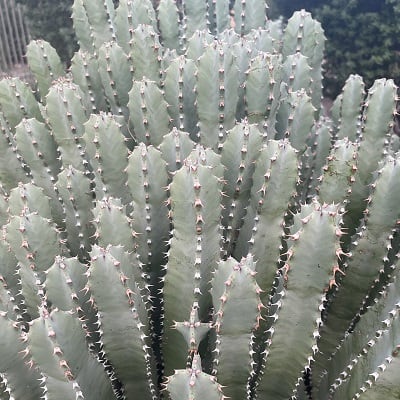
Euphorbia resinifera is a dense succulent shrub growing to 60 cm tall, forming multi-stemmed cushion-shaped clumps up to 2 m wide.
Euphorbia restricta
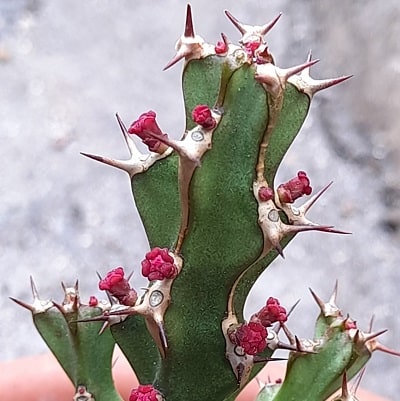
Euphorbia restricta is a small spiny, succulent subshrub, basally branching, from a large tuberous root and usually less than 30 cm tall. The Euphorbia restricta has stems branching freely.
Euphorbia ritchiei
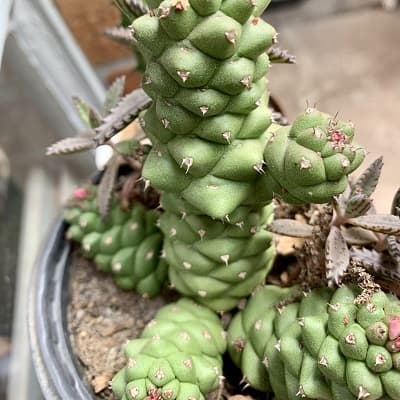
Euphorbia ritchiei (Monadenium ritchiei) has long pale green, decumbent stems to 60 cm tall and 3 cm wide with tubercles in loosely spiraled series. The plant has puberulous leaves. The bract-cup is grayish-green.
Euphorbia rossii
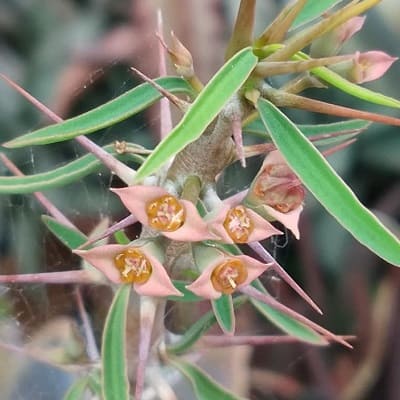
Euphorbia rossii is a weird spiny branched succulent with long thin leaves in summer and just a bunch of spiny sticks in winter. The color of the flowers varies from one plant to another from olive-green, to yellow to orange to red.
Euphorbia royleana
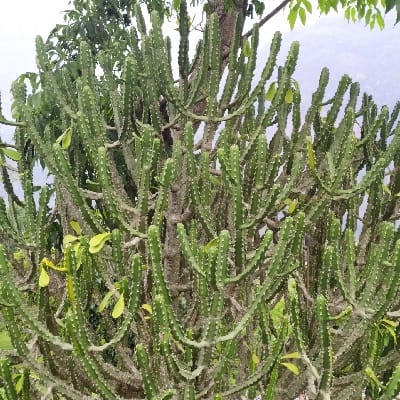
Euphorbia royleana is a deciduous, cactus-like, shrub or small upright tree up to 2-5(-7) m high, armed with short prickles, with a stout trunk, and glabrous except for cyathia. The stems become leafless during hot and cold seasons. The flowers (cyathia) are small greenish-yellow, 3-4 in almost stalkless clusters in leaf axils.
Euphorbia sakarahaensis
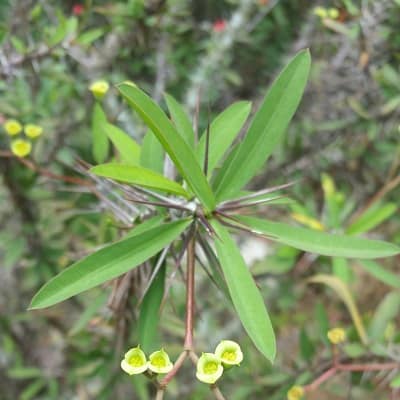
Euphorbia sakarahaensis, as is implied by the specific name, is a little-known and localized species confined to the Sakaraha forest in northern SW Madagascar. It is a deciduous caudiciform shrublet 30-50 cm tall and wide.
It is low-growing with few branching spiny shoots and small yellow-green to dark brown petal-like cyathophylls (colored bracts around the cyathia). This species is related to Euphorbia neobosseri but less branching, with shorter spines and variably colored cyathophylls.
Euphorbia schoenlandii
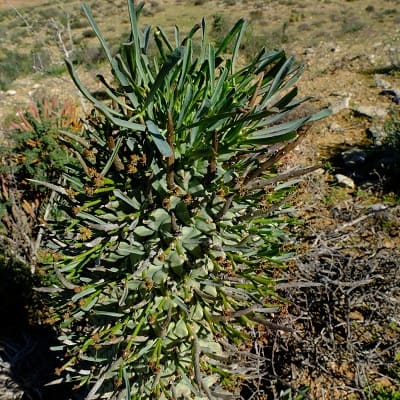
Euphorbia schoenlandii is a small pickle-shaped succulent shrublet with prominent spiny tubercles, sometimes resembling a green pineapple, usually single-stemmed but may branch with age.
Euphorbia schubei
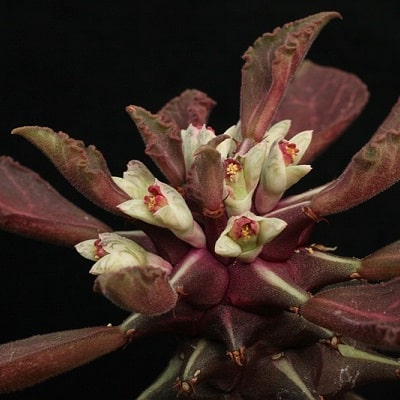
Euphorbia schubei is a perennial shrubby succulent herb, that branches mostly from the base and forms large mats with time. The stems are stout to 5 cm thick, erect sometimes to nearly 1 m high or reclining on the ground but with ascending apex.
These are covered with prominent tubercles, each crowned by a cluster of 5 tiny spines at the base of minutely hairy leaves and producing in their axils cymes with pink-rimmed cyathia (flowers) enclosed by pinkish-grey bracts.
Euphorbia sepulta
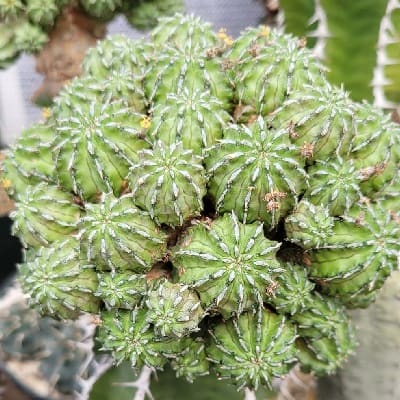
Euphorbia sepulta is a rare, compact, succulent perennial that forms impressive flattened cushions about 3 cm high and up to 30 cm diameter (more hemispherical in cultivation), with very compact branching mostly below ground-level from the apex of a very thick fleshy root.
Euphorbia silenifolia
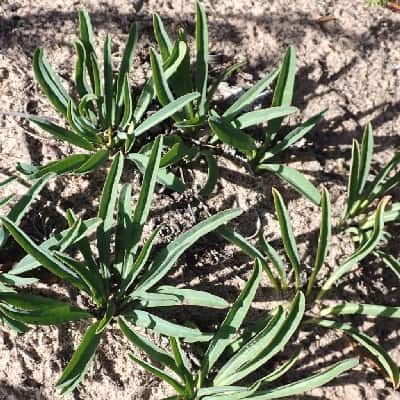
Euphorbia silenifolia (like the leaves of Silene or Catchfly) is a dioecious, perennial succulent herb with an ellipsoid, subterranean tuber (geophyte) which grows during the winter months. Its tuberose roots merge into underground stems (caudexes) with a tuft of narrow tapering leaves and flowers above ground.
The plants are not visible during the summer. During autumn the thin leaves start to grow from the apex of the underground stem. The plant is 15 cm tall, flowering in winter.
Euphorbia sipolisii
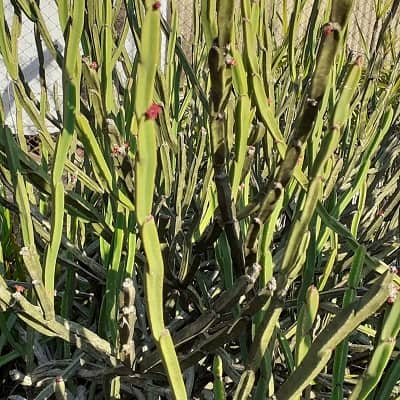
Euphorbia sipolisii is a cereiform, succulent shrub from Brazil. It branches profusely at the base from a short stem and above into a multitude of erect green stems, radiating out to form a rounded bush up to1 m high and as much or more in diameter.
It is similar to Euphorbia pteroneura and Euphorbia phosphorea but stems with 4 rounded ridges and grooved sides. It is uncommon in cultivation except in specialist collections. The flowers are dark red and glossy.
Euphorbia spectabilis

Euphorbia spectabilis is a stout succulent shrub, with an unbranched or few-branched stem with cactus-like features that generally don’t come into growth until the summer.
The flowers are remarkably spectacular, born at the apex of the stem, small, dark pink, enveloped in scarlet bracts, and borne on a long, rich red, quadrangular stalk that bears fewer cartilaginous prickles. It makes an incredibly ornamental potted plant and is highly attractive to collectors.
Euphorbia spiralis
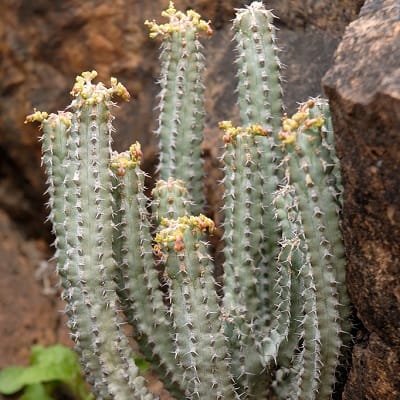
Euphorbia spiralis is a scrubby, leafless, cactus-like succulent related to Euphorbia polyacantha. It is the only spiny succulent euphorbia on Socotra, possessing thick succulent stems with rows of paired spines arranged along the longitudinal ridges.
The specific epithet spiralis coined by Balfour refers to the spiraling of the stem in specimens he observed, however, stems can be either straight or spiraling, and, in fact, spiraling of the stem seems rather rare.
Euphorbia spiralis individuals vary noticeably in shape some form a few branched open shrub while others have a distinct cushion-like growth-form, with the stems densely packed.
Euphorbia squarrosa
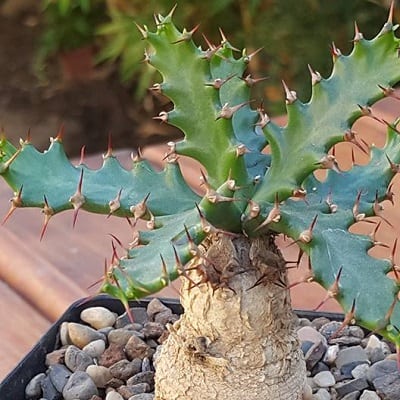
Euphorbia squarrosa is a spiny succulent Euphorbia with a fleshy underground root. Its three-angled stem distinguishes it from similar-looking Euphorbia stellata, which has strictly bilaterally flattened, two-ribbed branches.
Euphorbia stellata
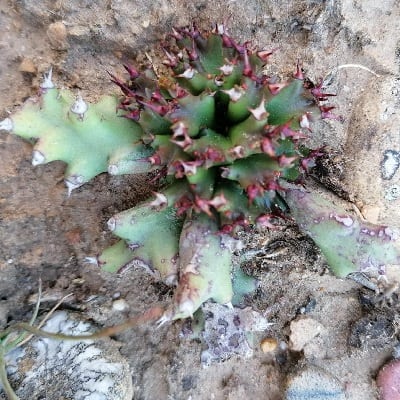
Euphorbia stellata is a small geophytic species, both a caudiciform and medusoid Euphorbia. It is very similar in body shape to the closely related Euphorbia squarrosa.
Euphorbia stellispina
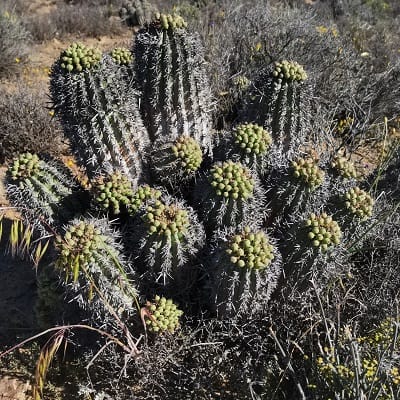
Euphorbia stellispina is a spiny succulent shrub branching from the base. The plant can produce massive, impressive clumps with up to twenty branches heavily armed with red-brown spines. The “spines” have a peculiar star-like appearance so characteristic of the species.
Both this species and Euphorbia pillansii have stellate (star-shaped) spines, but E. stellispina is distinguished by its larger size (up to 70 cm tall under ideal conditions) and its more numerous ribs (10-16 compared to 7-9 in E. pillansii) and the spines appear to be of different origin.
Euphorbia stenoclada
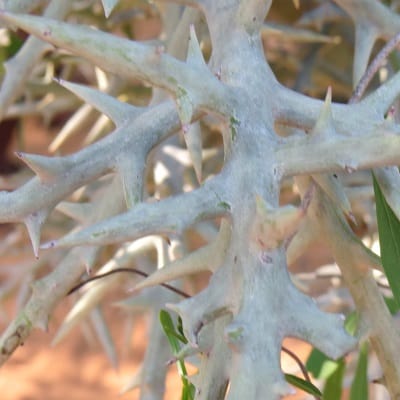
Euphorbia stenoclada is a much-branched silvery gray globose, bushy shrub or tree 1-4.5(-6) m tall with a flat-topped crown of branches. Its silhouette suggests a loose pile of plump snow-flakes, it forms thickets. This species exists in several forms, some spineless, others armed.
Euphorbia submammillaris
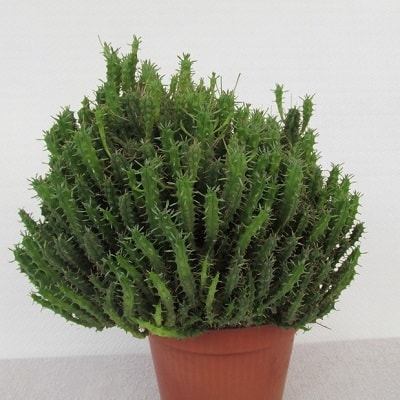
Euphorbia submamillaris is a poorly known taxon that may not be a good species (possibly a hybrid). It is known only in cultivation and appears to have some affinity with the ‘corncob’ species Euphorbia pulvinata or possibly a form of Euphorbia fimbriata.
Moreover, the plant found in cultivation are quite variable, and the dissimilarity among seedlings may be considerable.
Euphorbia susannae
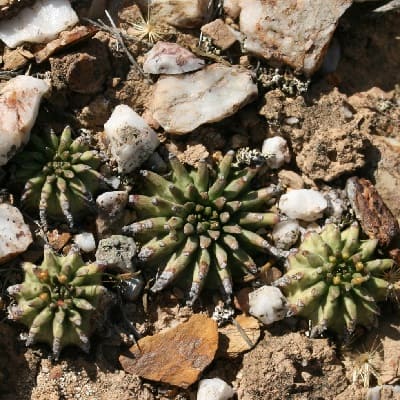
Euphorbia susannae is a small clumping or (rarely) solitary succulent, that forms nice hemispherical clumps up to 10 cm tall and 3o cm in diameter. It grows relatively fast for a small so small-sized plant.
Euphorbia tardieuana
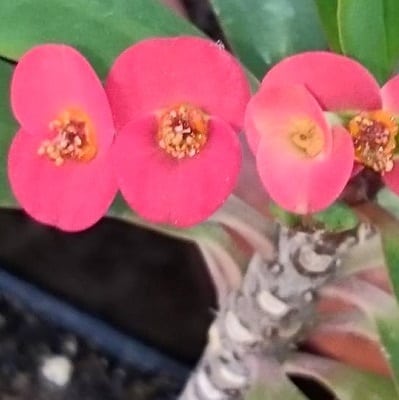
Euphorbia tardieuana is a semi-succulent shrub to 1 m tall that can be easily trimmed without harming the plant. The flowers are reduced in size and aggregated into a cluster of flowers cyathia, each of them subtended by a pair of conspicuous brilliant red petaloid bracts (cyathophylls) that resemble, from a distance, geraniums.
E. tardieuana is related, if not synonymous to Euphorbia mangelsdorffii.
Euphorbia tirucalli
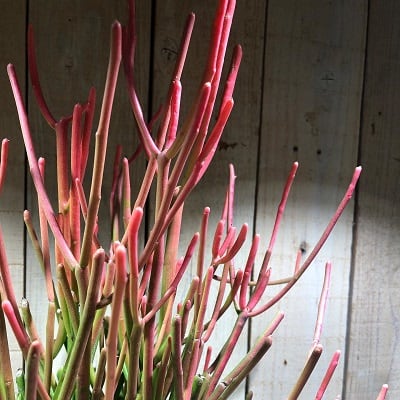
Euphorbia tirucalli is an unarmed succulent shrub often apparently dioecious growing to a height of about 5 m or a small tree up to 12(15) m tall with masses of cylindrical, pencil-like, succulent branches that form a dense crown. All parts of the plant ooze a caustic milky white sap at the slightest injury, like many other Euphorbia species.
Euphorbia tithymaloides
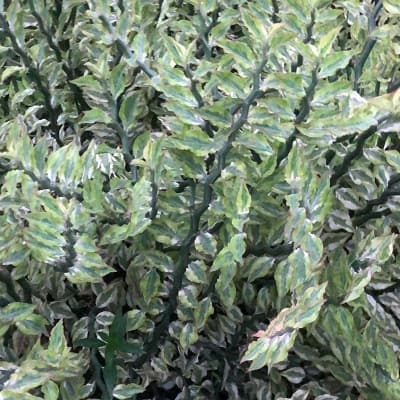
Euphorbia tithymaloides is an erect perennial succulent spurge growing to around 0.4 to 3 meters tall and 40-60 cm wide that branches profusely from the base. It produces abundant flowers (cyathia) with somewhat shoe-shaped reddish-colored involucrum bracts that give this species the common name Slipper Plant.
Euphorbia tortirama
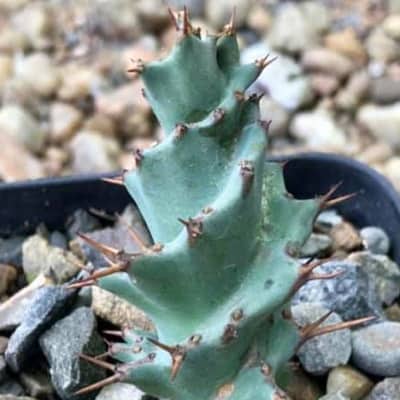
Euphorbia tortirama is one of the most interesting South African dwarf euphorbia bearing quaintly spiraled branches, a tuft of which arises from the top of a perennial tuberous rootstock. The thickened main root is raised above the soil level when potted.
Euphorbia trichadenia
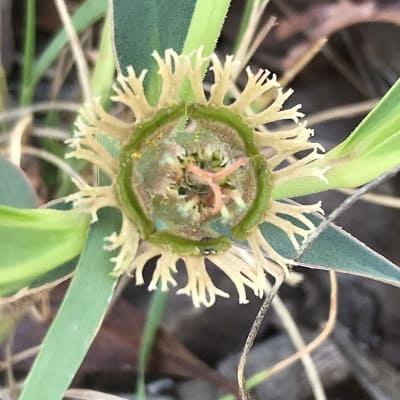
Euphorbia trichadenia is a perennial herb with a large cork-like barked rootstock (succulent caudex) 12 cm long and 6-20 cm in diameter, producing annual thin herbaceous or woody prostrate or erect stems to 12 cm high, branching from the base.
The leaves are narrow and acute, while the flowers, borne either singly in the forks of the branches or in terminal cymes of three to five, are pale yellowish in color.
Euphorbia trigona
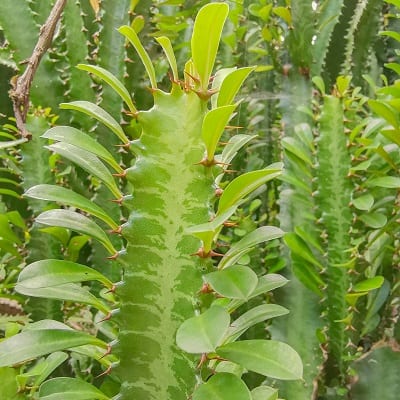
Euphorbia trigona is a tender, evergreen, succulent plant. The stems have three wing-like angles and carry short, sharp spines as well as leaves. Eventually, the plant grows into a densely and compactly branched erect shrub or small tree of two meters or more. Euphorbia trigona is widely cultivated as a pot plant.
Euphorbia truncata
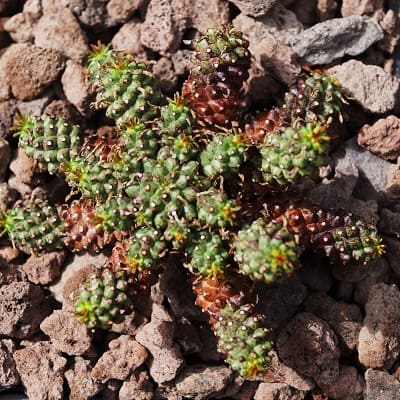
Euphorbia truncata is a very dwarf succulent plant, not rising more than 4-8 cm above the ground and 8-20 cm (or perhaps more) in diameter. Its branches have truncate tips, the inflorescence is unisexual and the ovary is hairy.
It is a dioecious, leafless, and spineless plant, consisting of a thick fleshy obconic body (caudex) tapering into the root system and buried nearly to the top in the ground and forming a flattish or somewhat rounded (with age) cushions built up little by little through the multiplication of its branching system.
Euphorbia tuberculata

Euphorbia tuberculata is a medusoid-looking succulent Euphorbia with an almost completely buried primary shoot with radiating tubercled branches. It slowly forms a rounded low-growing spineless rosette up to 60 cm tall and up to 75 cm wide.
Euphorbia tubiglans
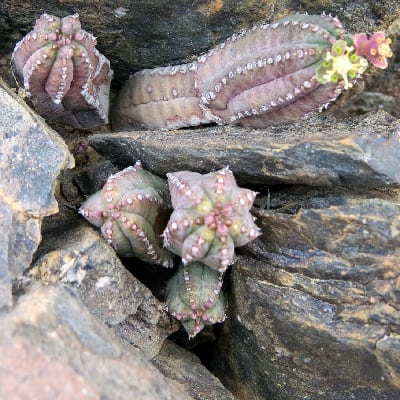
Euphorbia tubiglans is a tufted, unisexual (dioecious), spineless dwarf succulent distinguished by its thick, fleshy rootstock or caudex, which in turn produces a long taproot. The short main stem is constricted into a very narrow neck which joins the branches at the apex of the underground rootstock.
Several five-sided stems arise from its tip, they begin with a thin, stem-like part, which suddenly thickens. The ribs are gently dentate.
Euphorbia tulearensis
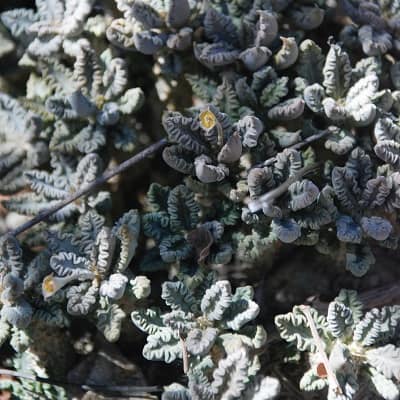
Euphorbia tulearensis is an adorable little succulent plant that develops a wooden tuberous caudex with a crown of short to elongate fat branches. It is one of the rarest of the Madagascan euphorbias and not common in cultivation.
It eventually becomes a small shrubby bonsai-like bush up to 20 centimeters in height and a bit wider over time. The Euphorbia tulearensis growth form illustrates the typical horizontal habit of most Madagascan euphorbias.
Euphorbia turbiniformis
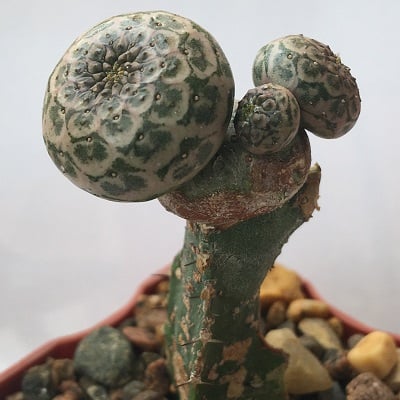
Euphorbia turbiniformis is a dwarf, spineless, globose succulent with beautiful tessellated markings.
Euphorbia umbellata
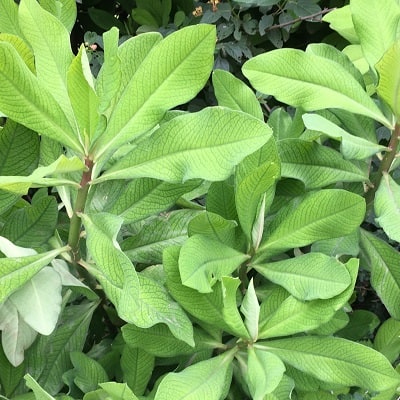
Euphorbia umbellata is a thornless semi-succulent, evergreen shrub or small tree, erect, richly branched from near the base and in its habitat becoming up to 3.5(-10) m in height with an equal spread. It is widely grown in the tropics for its giant fleshy leaves as an ornamental and hedge or cover plant and under glass in colder regions.
Euphorbia unispina
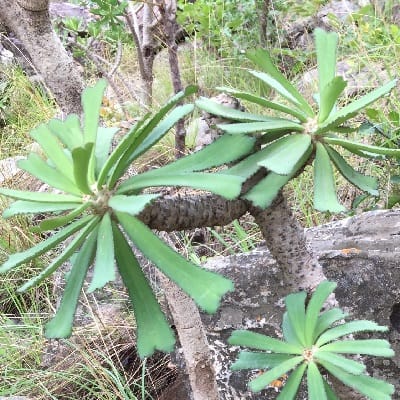
Euphorbia unispina is a stout, monoecious, candelabriform, cactus-like, shrub with a short thick stem, up to 3-3.5(-6) m tall, with 3-4 thick cylindrical branches and large thick fleshy erect leaves in a terminal rosette or tuft at the tips of the branches, naked below, or perhaps sometimes entirely leafless, spiny.
The branches are covered by a thin silver-grey mantle of cork and by polygonal tubercles (podaria) arranged in spiral lines, more prominent near the apex. The green leaves are very variable even in one and the same specimen. The cyathia (flowers) are green.
Euphorbia venenifica
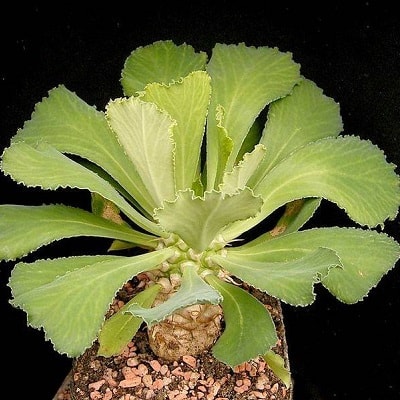
Euphorbia venenifica is a stout, erect succulent bush or cactus-like tree 2-5(-6) m high, branching from a short thick stem into a few or several cylindrical main stems, topped with large, prominently veined leaves during the growing season, occasionally sub-spiny. The stems occasionally branch loosely in an irregular manner. It produces small, lime yellow-green flowers in spring.
Euphorbia viguieri
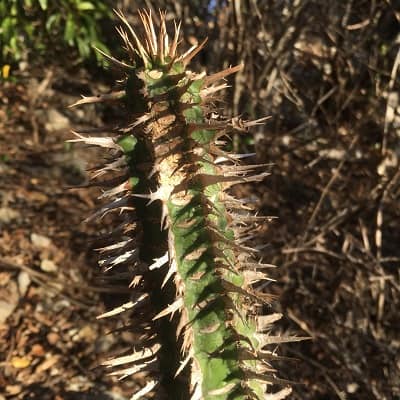
Euphorbia viguieri is a very handsome plant with an angular, bright green stem with vertical, spiraling whitish thorns and vibrant red top-knots of floral parts. It is not a cactus, although it looks like one.
Euphorbia virosa
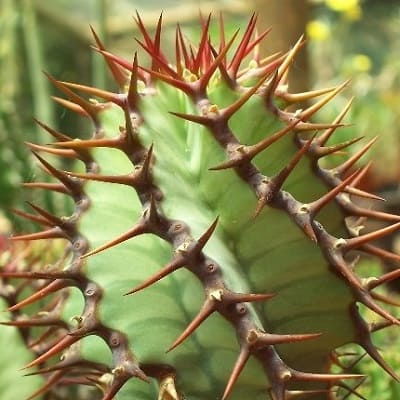
Euphorbia virosa or “poisonous spurge.” is a slow-growing but vigorous wide-branching cactus-like shrub or small tree with angled, upright, leafless and spiny stems, forming fairly dense clumps of growth, up to 1-1.5 meters, occasionally to 3 meters across and high; the numerous branches usually arise in whorls from the base conferring it a candelabra-like shape which is similar in appearance to the unrelated organ pipe cacti of the Americas.
The plant is protected against overheating by its irregular stem and light thorns that reflect the sunlight. It is well named, the “venomous euphorbia,” for the virulent poison of its milky latex, an effective defense against most herbivores (with the exception of the black rhinoceros).
Euphorbia vulcanorum
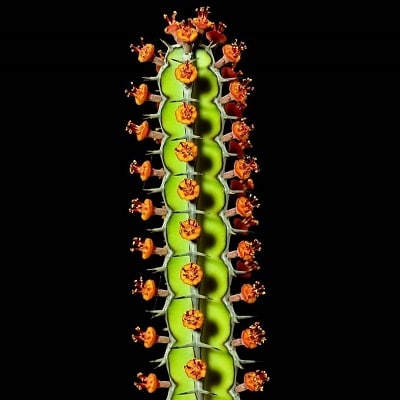
Euphorbia vulcanorum is a small densely branched spiny succulent shrub up to 1 m tall. The species is related to Euphorbia heterochroma and easily recognized by its thin 4-5 angled branches that are attractively marked with continuous spine shields and stout paired spines. The cyathia (flowers) are apricot-colored and very showy on those stems.
Euphorbia waringiae
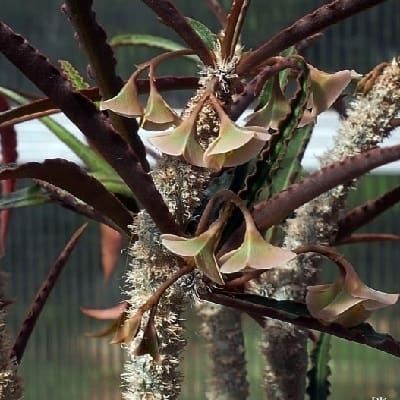
Euphorbia waringiae is a deciduous caudiciform shrublet, up to 30 cm tall. It is low-growing with branching shoots and small flowers.
Euphorbia xanti
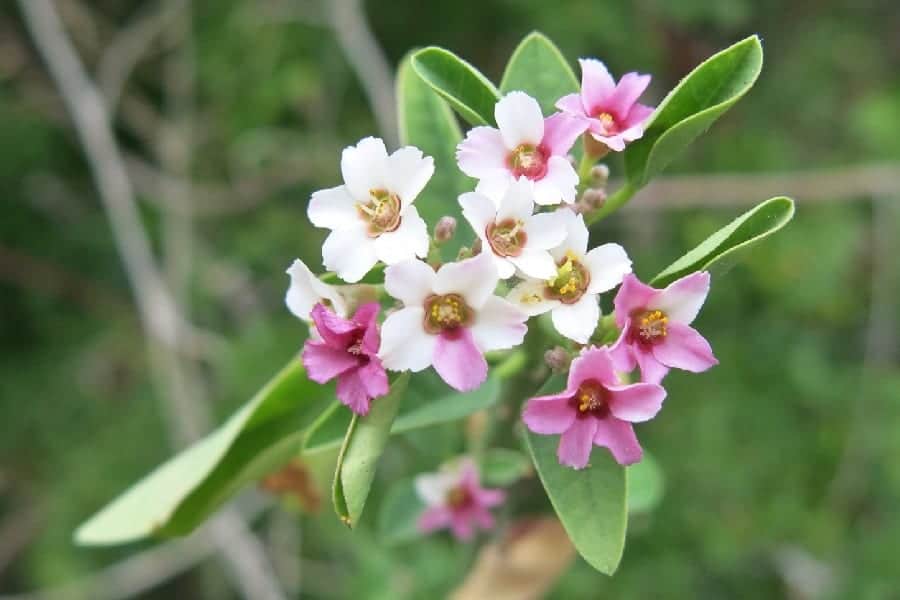
Euphorbia xanti is also known as Baja Spurge since it has its origins in Baja, California. This succulent tends to grow at a quick rate and can manage to reach a height of around 6 feet.
This plant has green leaves and darker stems along with pink and white flowers that usually bloom in the months of winter and spring.
Euphorbia xylophylloides
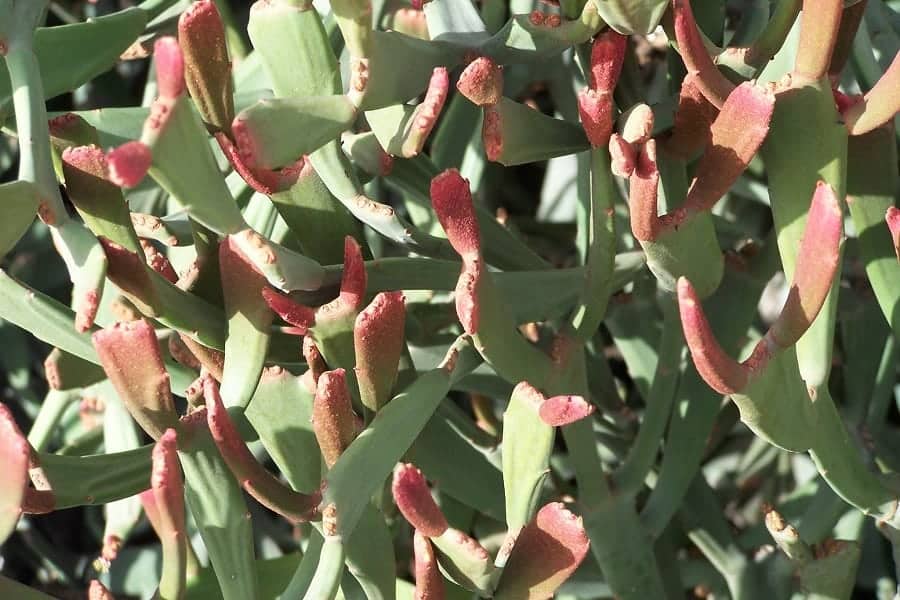
Euphorbia xylophylloides is a plant that has its origins in Madagascar. Often described as a leafless cactoid, this plant is full of green branches that grow in a group and resemble a shrub without growing any leaves across the structure.
These branches can manage to grow quite tall, often reaching an overall height of around 20 meters or 65 feet. While this plant bears yellow flowers, these are not usually distinctive.
Euphorbia zoutpansbergensis
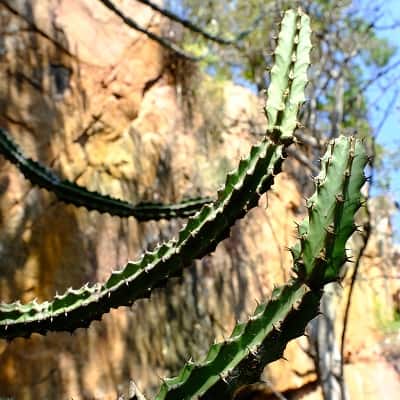
Euphorbia zoutpansbergensis is a rather handsome small single-stemmed tree or large shrubs with a large, dense crown of crowded arcuate-ascending branches towards the apex. It grows to a height of 6(-8) meters under favorable conditions, but usually doesn’t exceed 4 m high. It has a distinctive silhouette and looks a bit like a small candelabra, though branches are very closely spaced. It is very striking in full bloom.
Source:
Llifle
Euphorbia Care Guide
The thorns on these plants are about 0.6 inches long on average, but they can get as big as 1.2 inches over time if you take good care. There are about 2,000 species of these plants and they come in a variety of forms and sizes. These plants can grow to be as large as trees in some forms and some of them can be grown indoors too.
Some Euphorbia plants produce flowers that don’t look conventional and those who are dealing with these plants must watch out for a milky sap that can sometimes be poisonous. Here’s a look at your Euphorbia care and propagation guide.
Light
These plants need full sun, which means they need to get direct sunlight for at least six hours on a daily basis. They might need protection from the afternoon sun depending on how strong the sun in your region is.
You can identify this by looking for burns or yellow coloring when exposed to too much sun. But typically, they grow well when planted outdoors in a sunny spot.
If you plan to grow this plant indoors, you must place it near a window that gets lots of sunlight. People who take this route like to pick south-facing windows for this reason. That way the plant will get sunlight all day long. Alternatively, invest in a good grow light for succulents that can replace natural sunlight.
Watering
These plants grow actively from spring to the fall season and that is when it should get the right amount of water. The right amount in this case is just making sure that the top two inches of soil are never dry.
So, if you spot them in that condition you should water the plant. That usually happens once a week because these plants are pretty great about tolerating drought. That is because these plants are native to regions that are described as semi-arid and rocky.
Sometimes the soil dries up to the point that it starts to feel crispy. Ideally, you should not let it get there. Your worst-case scenario should still get the plant watered once every month.
The best time to water these plants is in the morning so that they have enough ammo to deal with the sun during the day. But in the winter season, you must change tactics and water the plant only when it looks like it is starting to wilt.
Read also: How often to water succulents?
Soil
These plants are a type of succulent which means they don’t need too much water. But that also means that they need well-drained soil as succulents do.
You can mix it with sand and add a little bit of perlite to the mix. If you add perlite, make sure that your potting soil and regular sand are mixed 50-50. Failing that, any commercial succulent potting mix will also get the job done. (We review the best soil for succulents in pots here.)
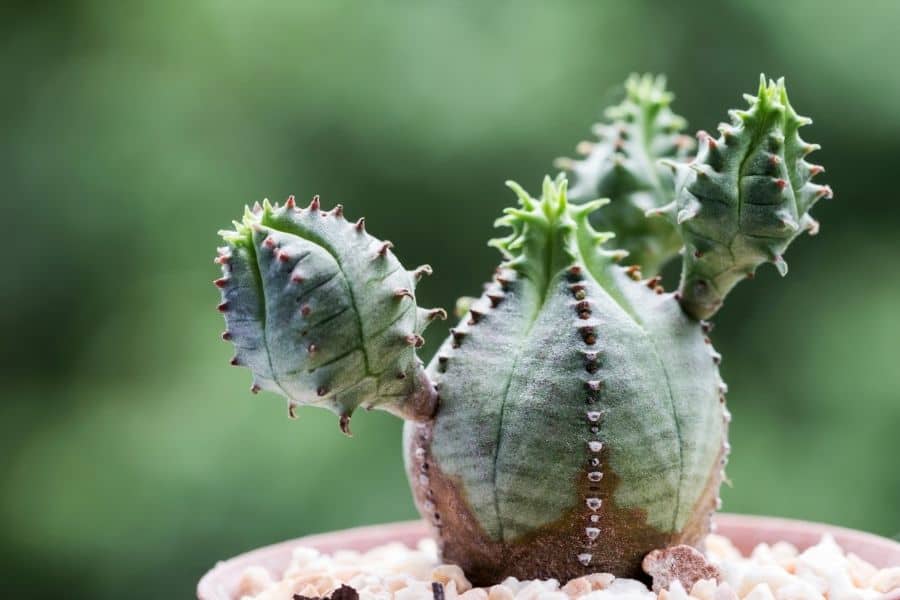
Fertilizing
Depending on the species, you will need to follow separate feeding techniques. But generally speaking, a little bit of fertilizing is good for these plants. You can add a little bit of organic fertilizer or compost to a young plant so that it grows healthily.
But you want to make sure that the fertilizer you are using is in liquid form and diluted a little to weaken it. You must also make sure that the fertilizer must be added to the plant in its growth period between spring and fall. In the winter, the plant is dormant and does not need to be fed as much.
Check out our article on the best fertilizer for succulents to help you choose the right one.
If your Euphorbia is in a container, you will have to feed it some more fertilizer compared to the ones that are being grown out in the ground. And if you notice yellow leaves developing at the bottom, that’s a sign that you need to feed the plant some fertilizer.
Climate
These plants are fairly easy to grow and maintain. That applies to the climate it is grown in too. You will need to ensure that the air is at least 50 percent humid throughout the year. If you are growing it indoors, you will be relieved to know that it grows okay in dry rooms too.
If you are looking for its best-case scenario, the temperature must be 70-80 degrees Fahrenheit during the day and 55-65 degrees Fahrenheit at night.
Pests and Diseases
Not many animals bother these plants thanks to the sap and the spines. But that does not discourage spider mites and mealybugs. They are the most common pest to attack these plants. And if it’s not taken care of right away, the attack turns into an infestation very quickly.
Propagating Euphorbia
These plants can be propagated in two ways: seeds and stem cuttings.
It is difficult for the seeds to germinate quickly which is why this is the tougher
method of the two. But if you take this route, you can get commercial sand mix and mix it in the same amount with coarse sand and plant the seeds in it. If there is
enough warmth, you will see growth in a couple of weeks. Otherwise, it can take 2-6 months.
